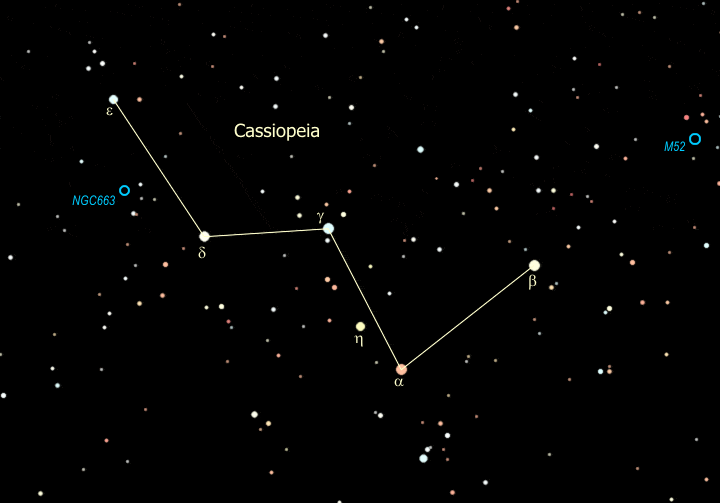The Cassiopeia constellation can be found in the northern sky and is named after a proud and boastful queen from ancient Greek mythology.
First observed by Ptolemy in the second century, Cassiopeia is part of the Perseus group of constellations (excluding Lizard). Its distinctive “W” shape makes it easy to identify in the night sky. Within Cassiopeia, there are several notable celestial objects, including the open clusters Messier 52 and Messier 103, the Heart and Soul nebulae, the remnants of the Cassiopeia A supernova, the star-forming cloud NGC 281, and the NGC 7789 cluster, also known as White Rose.
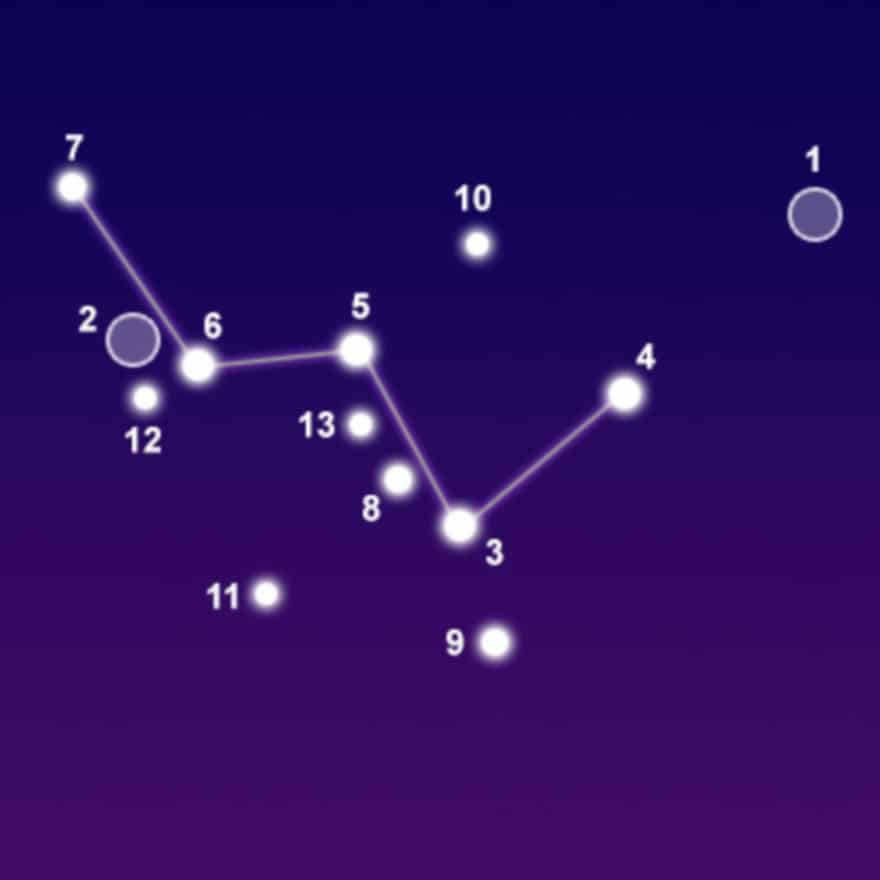
Interesting Information, Location, and Stellar Chart
Cassiopeia, which occupies an area of 598 square degrees, stands as the 25th largest constellation in the night sky. Situated in the first quadrant of the northern hemisphere (NQ1), it can be observed at latitudes ranging from +90° to -20°. This constellation shares its borders with Andromeda, Giraffe, Perseus, Lizard, and Cepheus.
Among its celestial inhabitants, Cassiopeia boasts three stars known to host planets, as well as two mesmerizing Messier objects, namely M103 (NGC 581) and M52 (NGC 7654). Shedar shines as the most luminous star in this constellation. Furthermore, the illustrious Perseid meteor shower is intimately associated with Cassiopeia. In the vast expanse of the night sky, Cassiopeia finds its place among other noteworthy constellations such as Andromeda, Cepheus, Lizard, Pegasus, Perseus, Triangle, Whale, and Ascendant. Take a closer look at a star map to explore the captivating arrangement of stars within the Cassiopeia constellation.

Legend
The constellation of Cassiopeia is associated with a fascinating mythological story. In ancient times, Cassiopeia was the queen of Ethiopia. She was known for her extraordinary beauty and was married to King Cepheus. However, her vanity got the best of her when she claimed to be more beautiful than the Nerids, a group of sea nymphs created by the titan Nereus.
Enraged by Cassiopeia’s arrogance, the Nerids sought revenge and approached Poseidon, the god of the sea. Poseidon, who was married to one of the Nerids named Amphitrite, couldn’t ignore their request for punishment. As a result, he decided to unleash a terrifying sea monster known as Cetus.
Cetus was depicted in the constellation of the Whale and was sent by Poseidon to destroy Cassiopeia’s kingdom. This monstrous creature brought chaos and destruction, leaving the kingdom in ruins. It was only through the heroic efforts of Perseus, a legendary Greek hero, that the kingdom was saved from Cetus and restored to its former glory.
The king sought assistance from the oracle, who advised him to offer his daughter Andromeda to Poseidon. After much difficulty, they agreed and chained her to a rock. However, at the last moment, Perseus came to her rescue and later married her. But the story doesn’t end there. During their wedding, Phineus, one of Andromeda’s admirers, appeared and accused her of betrayal, claiming that he alone had the right to marry her. Perseus fought back using the head of the Medusa Gorgon, turning Phineus and others who looked at her into stone, including the king and queen.
In response, Poseidon sent Cassiopeia and Cepheus to the heavens. Yet, he still punished Cassiopeia by transforming her into a constellation that appears upside down for six months. In most depictions, she is shown sitting on a throne and brushing her hair.
Main celestial bodies
Cassiopeia is known for its distinctive “W” shape, which is formed by five bright stars. These stars, from left to right, are Epsilon, Delta, Gamma, Alpha, and Beta Cassiopeia. Discover the prominent celestial bodies of the Cassiopeia constellation through detailed descriptions and characterizations.
Shedar (Alpha Cassiopeia) is an orange giant classified as a K0IIIa star, located 228 light-years away. It is considered a variable star, meaning its apparent magnitude can vary depending on the photometric system used. Its brightness ranges from 2.20 to 2.23 magnitudes. Shedar is positioned in the lower right corner of the W asterism and derives its name from the Arabic word “şadr,” which translates to “breast.” This star holds a significant place within the Cassiopeia constellation, representing its heart.
Kaf (Beta Cassiopeia) is a subgiant or giant star with a spectral type of F2 III-IV. It is located 54.5 light-years away from our position. This star belongs to the Delta Shield category of variable stars. In its class, only Altair, which is a star in the Eagle constellation and the 12th brightest in the sky, outshines it. Kaf is a yellow-white star that is 28 times brighter than the Sun and four times larger in size. Currently, it is in the process of cooling and will eventually evolve into a red giant.
Delta Shield type variable stars exhibit changes in brightness caused by pulsations on their surface, both radial and non-radial. These stars are typically giants or main-sequence stars with spectral types that range from A0 to F5.
The average apparent magnitude of Kaf is 2.27. In Arabic, “kaf” translates to “palm,” referring to the palm of the Pleiades, a well-known star cluster in the Taurus constellation. Other traditional names for Kaf include al-Sanam al-Naqa and al-Kaff al-Hadib.
Navi (Gamma Cassiopeia) is an explosive variable star that serves as a prototype for the variable stars of Gamma Cassiopeia. It displays irregular changes in brightness ranging from 2.20 to 3.40 magnitudes. It is the central star in the distinctive W-shaped constellation (currently known as such).
With a spectral type of B0.5 IVe, Navi is a blue star located 610 light-years away, shining with a brightness 40,000 times that of the Sun and possessing a mass approximately 15 times that of our solar system’s star. Its rapid rotation causes it to bulge at the equator, resulting in the creation of a “diminishing” disk composed of lost mass and material.
Notably, Navi emits X-ray radiation at a rate ten times higher than other stars of the B or Be class. It is also a spectroscopic double star, with a companion star weighing as much as the Sun and appearing eleven times fainter, situated at a distance of two arc seconds. This companion star completes a full rotation every 204 days.
The Chinese refer to it as Qih, which means “whip.” It is also known by the nickname “Navi,” which is derived from the name of astronaut Virgil Grissom. The name Navi is actually Ivan spelled backwards, and astronauts used this star as a reference point in their missions.
Rukbach, also known as Delta Cassiopeia, is a binary star system that undergoes eclipses with a period of 460 days. It belongs to the spectral class A5 and is located 99 light-years away. The star has an apparent magnitude ranging from 2.68 to 2.74 and is the fourth brightest in its cluster. Its name is derived from the Arabic word for “knee,” and it is sometimes referred to as Xora.
Seguin (Epsilon Cassiopeia) is a brilliant giant star with a white-blue hue. It belongs to the B-class and is located about 440 light-years from Earth. With an apparent magnitude of 3.34, it is 2500 times brighter than the Sun. This star is estimated to be around 65 million years old and is currently in the late stages of the hydrogen fusion cycle. One interesting characteristic of Seguin is its very weak absorption of helium in its spectral signature.
Achird (Eta Cassiopeia) is a dwarf star in Cassiopeia that is closer to our solar system compared to other stars in the constellation. It has a yellow-white color and belongs to the G-type hydrogen dwarfs. Achird is slightly cooler than the Sun, with a surface temperature of about 5,730 Kelvin. Its apparent magnitude is 3.45, making it visible to the naked eye. The distance between Achird and our solar system is only about 19.4 light-years.
Achyrd has a partner, an orange dwarf of the K-class with a visible magnitude of 7.51, located 11 arc seconds away. Both stars are part of the RS Hound Dogs variable star group. They form a close binary system and exhibit active chromospheres that result in the formation of large starspots. These spots cause fluctuations in brightness, with a variation of 0.05 magnitudes.
Zeta Cassiopeia is a subgiant star with a blue-white color (B2IV) located 600 light-years away. It has an apparent visual magnitude of 3.67. This star belongs to the SPB (slow pulsating B) variable star category and possesses a magnetic field. Its rotational velocity is 56 km/s, with a period of 5.37 days.
Rho Cassiopeia is a rare type of star known as a yellow hypergiant, with only 7 of its kind in the Milky Way galaxy. It is classified as a G2Ia0e star and is situated at a distance of 11650 light-years. Despite its great distance, it can be observed without the need for technical equipment due to its high brightness.
With an absolute magnitude of -7.5, V509 Cassiopeia is 550,000 times brighter than the Sun. Its apparent visual magnitude can range from 4.1 to 6.2. This star exhibits semi-regular variability, with significant outbursts occurring approximately every 50 years, which is responsible for its brightness fluctuations. In the year 2000-2001, V509 Cassiopeia experienced a massive outburst, ejecting a mass equivalent to 10,000 Earths.
Scientists hypothesize that this star exploded as a supernova due to the depletion of its nuclear fuel. However, if this is indeed the case, the light from the explosion has not yet reached us.
V509 Cassiopeia is classified as a G-type supergiant located 7,800 light-years away. This yellow-white star also exhibits semi-regular variability, with its luminosity varying between 4.75 and 5.5.
Heavenly bodies
Messier 52 (NGC 7654) is an open star cluster situated at a distance of 5000 light-years. With a visible magnitude of 5.0, it can be observed using binoculars.
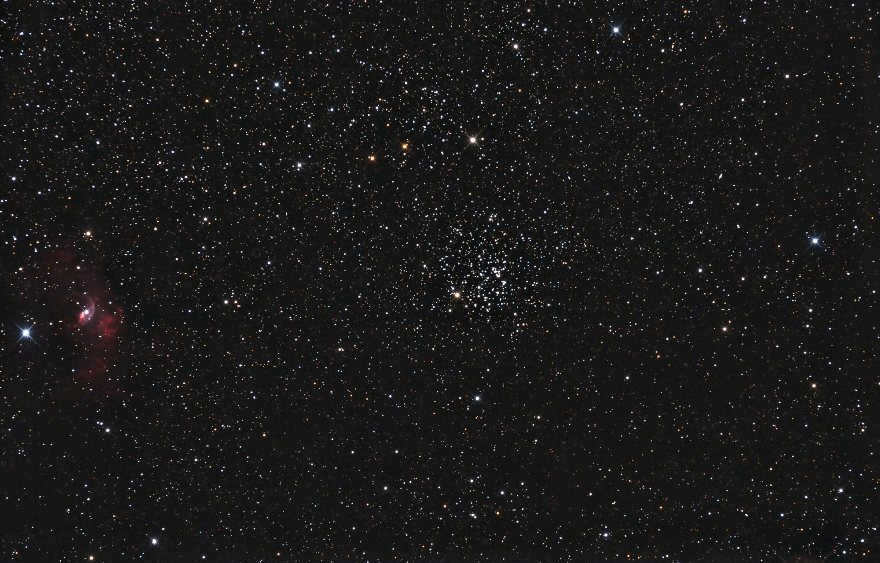
The age of the cluster is 35 million years and its diameter is 13 arc minutes (equivalent to 19 light-years).
Charles Messier discovered this cluster in 1774. The brightest stars in the cluster include two yellow giants with magnitudes of 7.77 and 8.22.
Messier 103 (NGC 581) is a cluster that was discovered 10,000 light-years away. It consists of 172 stars and is 25 million years old.
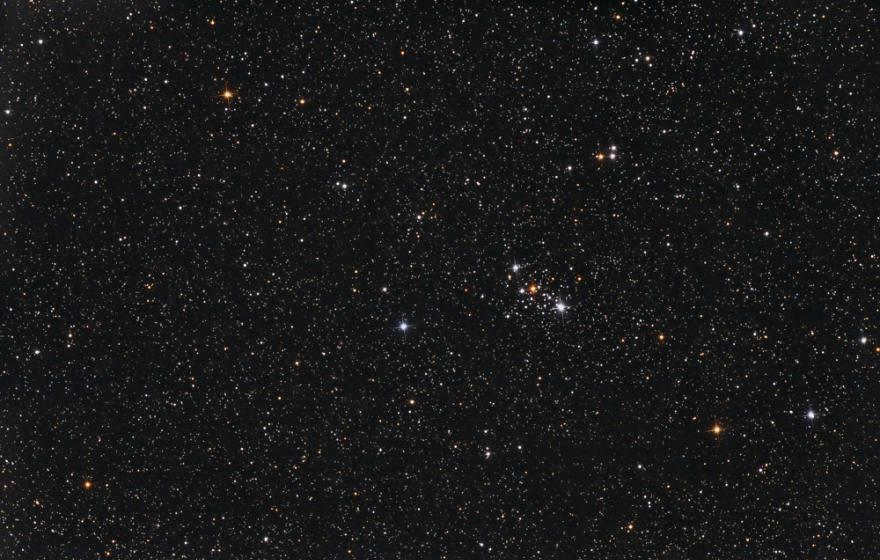
The constellation Cassiopeia contains a cluster that was discovered in 1781 by Pierre Meschen, an astronomer from France. Interestingly, this cluster was the final addition to Charles Messier’s catalog.
Cassiopeia A is actually a supernova remnant. It holds the distinction of being the most powerful radio source in the sky beyond our solar system, and it was one of the first radio sources to be detected in 1947.
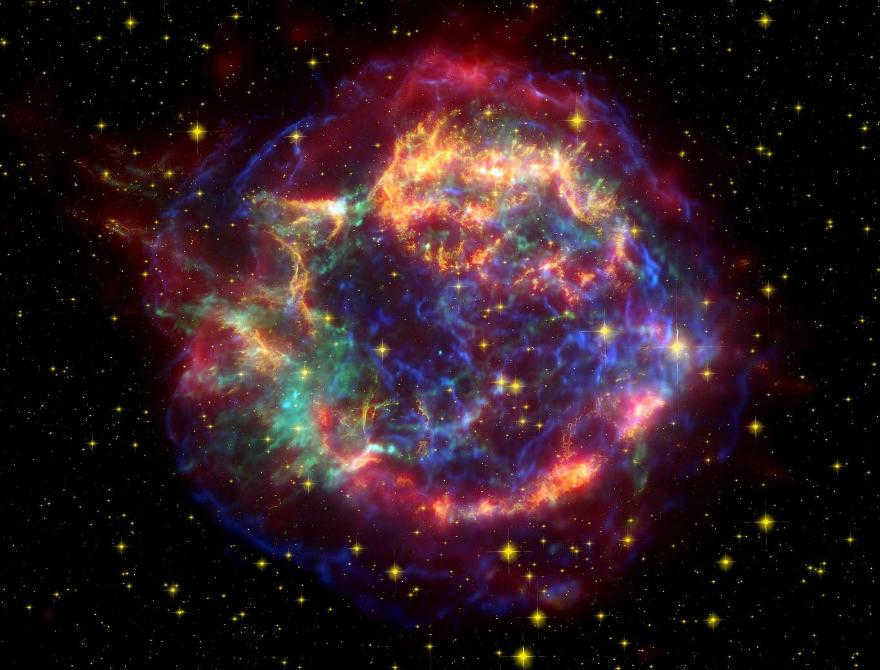
It is a celestial formation consisting of stars and other celestial bodies. The constellation Cassiopeia is known for its unique cloud of material that was expelled during a powerful explosion. This cloud spans a diameter of 10 light years and is currently expanding at a remarkable speed of 4000-6000 km/s. The temperature within this cloud reaches a staggering 50 million degrees Fahrenheit.
This explosive event took place approximately 11,000 years ago, but its first visible light only reached Earth 300 years ago. The remnants of this supernova continue to captivate astronomers and scientists, providing valuable insights into the nature of cosmic explosions.
Another fascinating celestial object is NGC 281, also known as the Pacman Nebula. This large gas cloud has recently witnessed the birth of new stars, as star formation has taken place within its boundaries. Notably, NGC 281 contains a significant amount of ionized atomic hydrogen (H II), which contributes to its stunning visual appearance. The young, hot, blue stars within this nebula are illuminated by ultraviolet light, creating a mesmerizing spectacle for astronomers and stargazers alike.
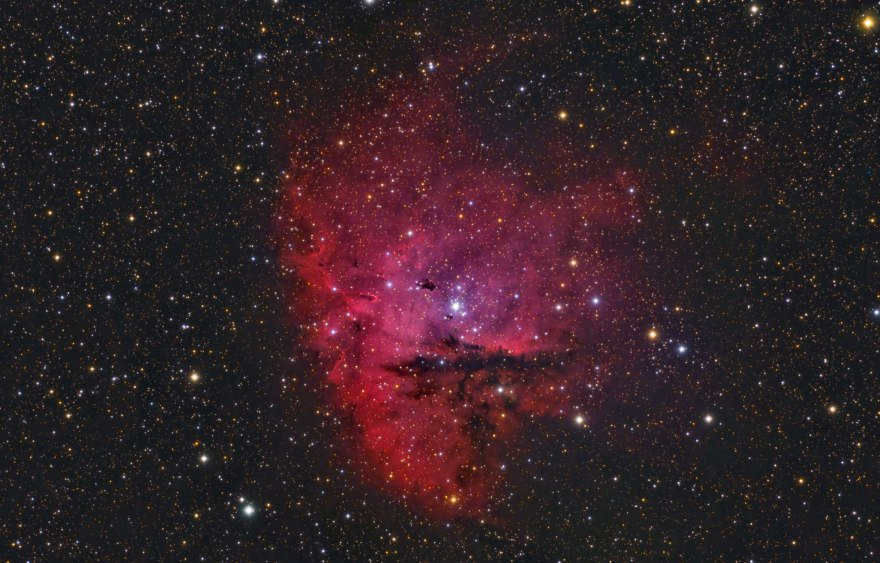
The Pacman Nebula got its name due to its resemblance to a popular video game character. Situated 9,500 light-years away from Earth, this celestial object was first discovered by American astronomer E. E. Barnard in 1883.
Another fascinating discovery is the star cluster known as NGC 7789, also referred to as the White Rose. Located 7,600 light-years away, it has an apparent magnitude of 6.7. Caroline Herschel, a British astronomer, first observed this cluster in 1783. The unique loops of stars within NGC 7789 resemble the delicate petals of a rose.
NGC 185, also known as Caldwell 18, is a dwarf spheroidal galaxy positioned 2.08 million light-years away. It serves as a companion to the Andromeda Nebula and belongs to the Seyfert type, featuring an active galactic nucleus. This galaxy contains young star clusters and exhibits signs of ongoing star formation.
John Herschel discovered NGC 147, also known as Caldwell 17, in 1787. The first image of this dwarf spheroidal galaxy was captured by James Keeler using the Crossley Telescope (36 inches/910 mm) at Lick Observatory, California, between 1898 and 1900.
Located 2.53 million light-years away from Earth, NGC 147 is a satellite of the Andromeda Nebula and a member of the Local Group of galaxies. It was originally found by John Herschel in 1829 and has an apparent visual magnitude of 10.5.
If you want to explore the constellation Cassiopeia in more detail, you can use not only our photo and diagram but also 3D models and an online telescope. An starry sky map is also available for independent search.
Diagram of the Cassiopeia constellation. Some details about the Cassiopeia constellation.
What is Cassiopeia? Cassiopeia is a constellation located in the northern hemisphere of the sky. The brightest stars in Cassiopeia (ranging from 2.2 to 3.4 stellar magnitude) form a shape that resembles the letters “M” or “W”. This constellation occupies an area of 598.4 square degrees in the sky and includes approximately 150 stars that can be seen with the naked eye, with 90 of them being brighter than 6m. The majority of this constellation is situated along the Milky Way belt and contains numerous scattered star clusters.
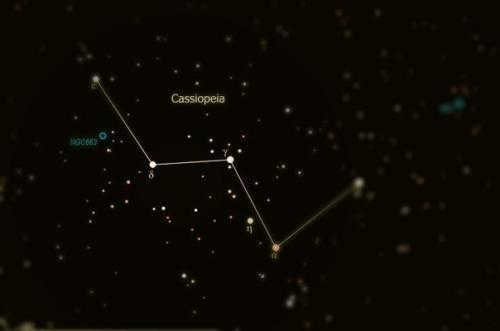
The Cassiopeia constellation is visible throughout most of Russia, except for a small portion in the southern region where it briefly disappears below the horizon.
The star in the constellation Cassiopeia, known as Cas, was first observed by Danish astronomer Tycho Brahe in 1572. It appeared suddenly and was very bright, but gradually faded and disappeared after sixteen months. Scientists now believe that this star was actually a supernova, one of the last star explosions ever observed in our Milky Way galaxy. This particular supernova is located about 7,500 light-years away and its remnant is approximately 20 light-years in diameter.
Cassiopeia also contains another significant astronomical phenomena called Cassiopeia A, or Cas A. This source emits extremely powerful galactic radio waves, much stronger than those emitted by the star Tycho Brahe. In 1951, red-light sensitive photographic plates captured images of a small radio nebula associated with Cassiopeia A. By measuring the expansion rate of the nebula, scientists estimated that the explosion which created it likely occurred around 1667. In the sky, Cas A can be found between Cassiopeia and the constellation Cepheus.
Scattered star clusters M52 (NGC 7654), M103 (NGC 581), NGC 457 and NGC 7789, dwarf elliptical galaxies NGC 147 and NGC 185 – satellites of the Andromeda Nebula, diffuse nebula NGC 281.
Giant gas sphere – bubble nebula (NGC 7635.
The nebulae IC 1805, IC 1848, and IC 1795, which are associated with the radio sources W4, W5, and W3, respectively.
An ancient constellation. It is part of Claudius Ptolemy’s Almagest catalog of the night sky.
Named after Cassiopeia – in Greek mythology, she was the wife of the Ethiopian king Cepheus and the mother of Andromeda. According to one version of the myth, Cassiopeia was punished for her arrogance and was tied to a chair, destined to rotate around the North Pole with her head facing downwards.
In some Arabic manuscripts, the constellation is referred to as “The Sitting Woman.”
The Arabs perceived the arrangement of the celestial bodies as a hand gesturing towards the stars ahead.
The most favorable conditions for observing Cassiopeia occur from September to November. It remains visible throughout Russia all year long. By drawing a straight line through the North Star and the Big Dipper, it will lead to the constellation Cassiopeia.
Both the Ursa Major (Great Bear) and Cassiopeia are constellations that do not set below the horizon for mid-latitudes. However, they are located on opposite sides (almost diametrically opposite) of Polaris. When Ursa Major sinks low on the horizon during the evening of the fall and winter, Cassiopeia rises nearly to the zenith, and vice versa.
Only when observing the sun from Alpha Centauri, one of the nearest stars to us, it will appear in the shape of Cassiopeia and will have a magnitude of 0.5. In this scenario, Cassiopeia will resemble /\/\/ with the sun positioned near it.
In Stephen King’s novel The Green Mile, the constellation Cassiopeia is mentioned. The protagonist of the novel, John Coffey, refers to the constellation as “Cassie the lady in the rocking chair,” which reflects an American folkloric interpretation of an ancient myth. Additionally, the novel The Langoliers also makes reference to the constellation Cassiopeia.
The movie “Intuition” (2001) also mentions the constellation Cassiopeia. In this film, the main character Jonathan (played by John Cusack) shares a myth about the constellation with a girl named Sarah (portrayed by Kate Beckinsale).
The star alpha Cassiopeia is the target of an expedition in the Soviet science fiction film, Moscow-Cassiopeia / The Descendants in the Universe dilogy, produced by the Gorky Film Studio in 1973-1974.
Cassiopeia is the official fan club of the band Dbsk.
In J. R. R. Tolkien’s Middle-earth, the constellation Cassiopeia corresponds to the wilvarin (butterfly) see. Stars of Middle-earth.
In his book “The Starry Sky and its Wonders,” Flammarion discusses the work of an English writer who wrote about the star Cassiopeia. The writer’s work entails a marvelous history of one of the worlds in space, along with a description of the peculiar nature, habits, travels, and literary productions of its inhabitants. Flammarion claims to have discovered the manuscript of this book in an empty bolide found in the Himalayas.
The constellations Orion, Cassiopeia, and Swan. Page 31. Starry sky
Detailed solution part 1 (page) Page. 31 on the workbook for 2nd grade students about the surrounding world, authored by A.A. Pleshakov in 2016
- You can find Gdz on the Environment for 2nd grade
- You can find Gdz tests in the Environment for 2nd grade
- You can find Gdz control and measurement materials on the Environment for 2nd grade
1. (p. 31) These illustrations from an ancient star atlas depict the constellations that you have learned about in class. Use the textbook to identify and label them.
2. (p. 31) Use the textbook illustrations to connect the dots and create diagrams of the Cassiopeia, Swan, and Orion constellations.

3. (p. 31) Please arrange the constellations of the zodiac on page 32 according to the order in which they are “visited” by the Sun. There are a total of 32 constellations in the zodiac. Let’s begin with the constellation Aries.

4. (с. 32) By utilizing the “From Earth to Heaven” identification atlas, you can identify the names of two prominent stars within the constellation Orion. On the constellation model provided in the textbook, make sure to label these stars accordingly. For further information about these stars, refer to the atlas-definers. Additionally, try to locate and observe them in the night sky.
The two most prominent stars within the Orion constellation are Rigel and Betelgeuse. They are scientifically referred to as Beta and Alpha Orionis, respectively. Both of these colossal stars are easily visible from Earth. One could argue that they compete for the distinction of being the primary star within this celestial formation. While Betelgeuse is labeled as Alpha, Rigel is slightly brighter.
Diagram illustrating the arrangement of stars in the constellation Cassiopeia. The constellation Cassiopeia
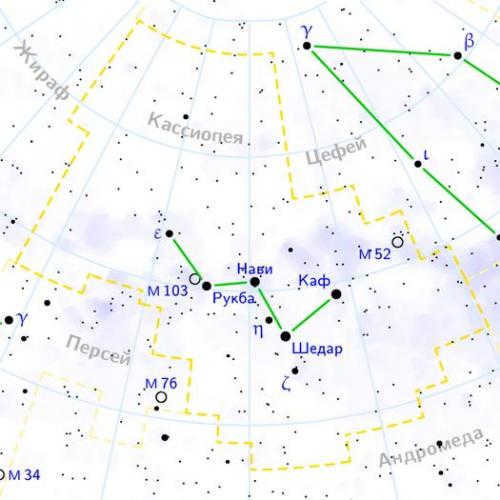
The constellation Cassiopeia is located in the northern hemisphere and was initially charted by the astronomer Ptolemy in the 2nd century. It was named after Queen Cassiopeia, who was a ruler of the legendary kingdom of Ethiopia.
According to Greek mythology, Cassiopeia offended the Nereids, sea nymphs, by bragging about her beauty. As a consequence, she was forced to sacrifice her daughter Andromeda to a sea monster known as the Whale, which was sent by Poseidon. As an additional punishment, Cassiopeia was placed upside down at the celestial pole and became a permanent fixture in the night sky. The constellation is easily recognizable due to five bright stars that form the distinctive shape of the letter ‘W’.
- Shedar (α Cas)- 2.24 m
- Kaf (β Cas)- 2.27 m
- Navi (γ Cas)- rm, 2.47 m
- Rukba (δ Cas)- 2.68 m
- Giraffe
- Cepheus
- Lizard
- Andromeda
- Perseus
The most prominent stars and celestial objects in the constellation Cassiopeia
Beta of the constellation Cassiopeia or Kaf (“palm”) is a yellow-white giant with a magnitude of 2.28 and is classified as a Delta Shield type variable star. It is twice the size of the Sun and 28 times brighter than it.
The alpha of the constellation Cassiopeia, Shedir or Shedar (“breast”) has an apparent stellar magnitude of 2.25 and is the second brightest star in the constellation. This orange giant is more than 500 times brighter than the Sun.
The central star of the Cassiopeia constellation is known as Gamma. It is a variable star and does not have a traditional Latin or Arabic name. However, in Chinese, it is called Tsih, which translates to “whip”. At its maximum intensity, Gamma outshines both Alpha and Beta Cassiopeia, with an apparent stellar magnitude of 2.15. This star rotates rapidly and has a wider equator, causing it to lose mass.
Delta, also known as Ksora or Ruchbah, is another star in the Cassiopeia constellation. It is a double star located approximately 99 light-years away. The apparent magnitude of Delta varies between 2.68 and 2.71.
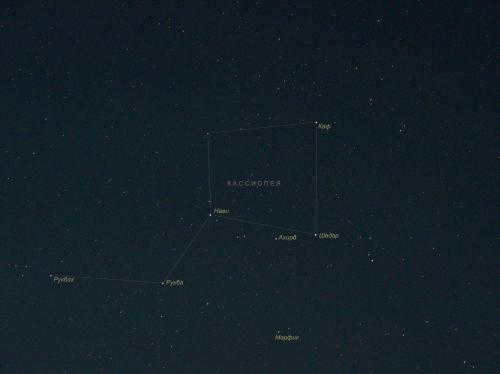
Epsilon, also known as Segin, is a blue-white giant star located approximately 442 light-years away from Earth in the constellation Cassiopeia. It possesses a luminosity 720 times greater than that of the Sun.
Within the galaxy, the Cassiopeia Rho and V509 Cassiopeia are the most prominent stars visible to the naked eye. Eta Cassiopeia, on the other hand, is a binary star system composed of a yellow dwarf resembling our Sun and an orange dwarf.
Cassiopeia also contains two significant objects identified in the Messier catalog. One of them is the star cluster NGC 7654, discovered by Charles Messier in 1774, which can be observed using binoculars.
Messier 103, also known as NGC 581, holds the distinction of being the final object to be recorded in Charles Messier’s catalog. Situated a staggering 8,000 light years away from our planet, it stands as one of the most remote star clusters to have been cataloged. Within its confines, one can find a collection of approximately 40 to 50 stars, with the most brilliant among them being Struve 131, also known as HD 9311.
During the year 1572, a celestial event of great significance took place, known as the Tycho star or CN 1572 supernova. This occurrence was meticulously documented by the esteemed astronomer Tycho Brahe. Presently, scientists are diligently studying a star known as Tycho G, as it may potentially serve as a companion to the star responsible for the supernova. Within the constellation of Cassiopeia, one can find another supernova remnant, which serves as the most potent source of radio emissions beyond our solar system that can be observed. The cloud of material left behind by the supernova now spans a distance of approximately 10 light-years.
In conclusion, there is an irregular galaxy named IC 10 within the constellation Cassiopeia. This particular galaxy was initially observed by Lewis Swift in 1887. Its close proximity to the Milky Way and its position behind interstellar space make it challenging to investigate. Nonetheless, IC 10 stands out as the sole star-forming galaxy within the Local Group.
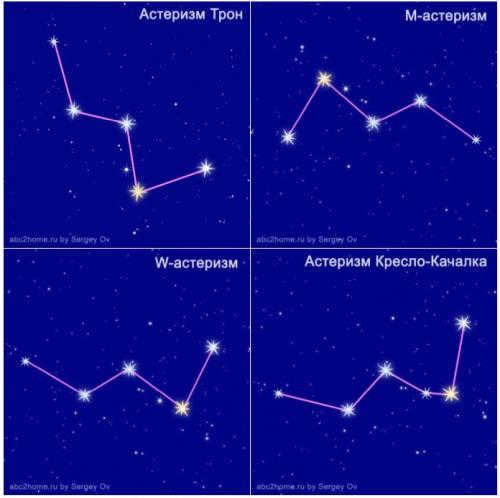
The constellation Cassiopeia can typically be located by most people through the asterism Throne. It is advisable to have someone point out this Throne to you – seeing this arrangement of stars in the sky just once is enough for it to become easily recognizable forever!
If you are on your own, you can find the constellation Cassiopeia using the following steps:
- If you are living around the latitude of Moscow, then starting from the beginning of autumn, go outside at around midnight local time. You will find the asterism Throne right above your head, in the zenith. All you need to do is accurately determine the angular dimensions of the throne and mentally align its pattern with the stars.
Using an extended hand, it is possible to estimate the angular size of the group of stars known as Tron in the constellation Cassiopeia. This particular image highlights the compact arrangement of the bright stars in Cassiopeia.
- A reliable method for locating Cassiopeia throughout all seasons is to align the beam with known stars. For the most accurate alignment, one should extend a line from Aliot (ε UMa) and pass behind Polaris (α UMa), resulting in a precise alignment with Gamma Cassiopeia Navi. Additionally, upon closer inspection, it becomes apparent that the prominent asterism known as the Big Bucket and the Throne Cassiopeia are symmetrically positioned with respect to Polaris.
To find the brightest star Cassiopeia Navi, you can mentally connect the Big Dipper Aliot and Polaris by drawing a line through them. Another option is to draw lines from any of the stars in the handle of the Big Dipper to Polaris, as all of them will also lead to Cassiopeia. In the late spring evening, you can observe Cassiopeia and the Throne in a configuration resembling the figure of the 7 Big and Little Bears, as shown in the image.
Diagram of the Cassiopeia constellation for second graders.
Displayed here is a visual representation of the prominent stars that form the well-known constellation Cassiopeia.
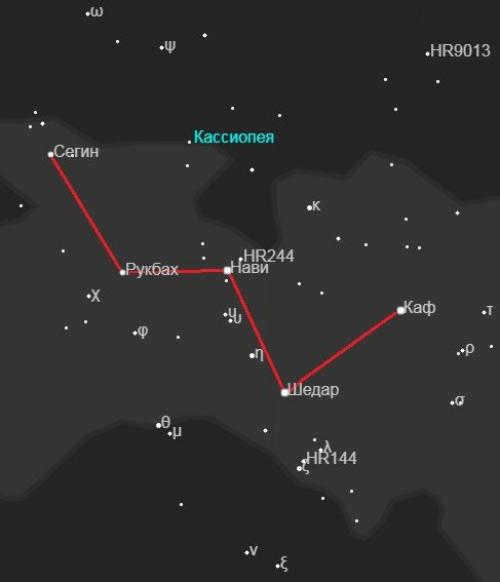
In Cassiopeia, there are only five main stars which are quite bright. They are arranged in the form of a distinct figure and each has its own name: Shedar – alpha Cassiopeia, Kaf – betta Cassiopeia, Navi – gamma Cassiopeia, Rukbach – delta Cassiopeia, and Segin – epsilon Cassiopeia.
The other stars in Cassiopeia are much dimmer and are not usually connected by conventional lines. However, the brightest among them can still be seen with the naked eye and are designated by Greek alphabet letters.
The bright nebula in the background of the diagram represents the Milky Way.
Interestingly, the Milky Way is often not visible in urban areas, but by locating the Cassiopeia constellation, one can estimate its approximate path and try to observe it.
According to ancient tales, it is said that Andromeda is the offspring of King Cepheus from Ethiopia and Cassiopeia, who was rescued by Perseus from a ferocious sea creature. Andromeda was bound to a cliff, left at the mercy of the monster. Perseus caught sight of Andromeda and was captivated by her exquisite appearance. He proposed a deal to the king – if Andromeda agreed to marry him, Perseus would vanquish the monster. King Cepheus agreed to the terms and Perseus effortlessly slayed the sea creature. According to the legends, Andromeda went on to bear Perseus several children.
The earliest recorded mention of the constellation Andromeda can be traced back to the 2nd century AD, when the Greek astronomer Ptolemy included it in his catalogue “Almagest” using this very name.
The Swan constellation. The story behind the Swan constellation
The Swan constellation, also known as Cygnus (from Latin Cygnus), is one of the most well-known constellations in the northern hemisphere. It was first documented by the ancient Greek astronomer Ptolemy in the 2nd century AD. This constellation resembles a bird with a long neck and wide-spread wings.
The Swan constellation has various legends associated with it. In one myth, the musician and poet Orpheus was transformed into a swan after being killed by the Maenads. He was placed in the sky next to the Lyra constellation, which is represented as the Lyra constellation. Another story tells of Zeus transforming himself into a swan in order to seduce Leda, the wife of the Spartan king Tyndareus. As a result of their union, Leda gave birth to Castor, Pollux, Clytemnestra, and Helen of Troy.
The Chinese constellation known as the “Bridge of Forty” is so named because it serves as a connection between the constellations of the lovers known as the “Shepherd” and the “Weaver”. According to ancient legend, the Goddess of Heaven discovered that these two lovers were married and decided to separate them, as the “Weaver” was a celestial being and could not be with a mortal. The husband, determined to reunite with his wife, took their two children and ascended to heaven, but the goddess refused to allow them to be together. In order to keep them apart, she created a wide river in the sky, using her hairpin. This river is symbolized by the Milky Way, which lies between the stars Altair and Vega. However, once a year, something magical happens. All the magpies in the world gather and form a celestial bridge, allowing the lovers to meet and be together, if only for a brief moment.
The Cassiopeia constellations: A closer look at celestial bodies and their descriptions
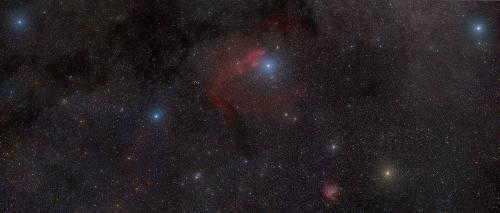
The constellation Cassiopeia is fully immersed within the summer Milky Way, indicating that it contains a wealth of celestial objects. In fact, Cassiopeia is home to over twenty remarkable diffuse star clusters. To observe these clusters, a powerful astronomical binoculars or a refractor with an aperture of at least 100mm and a wide field of view are recommended.
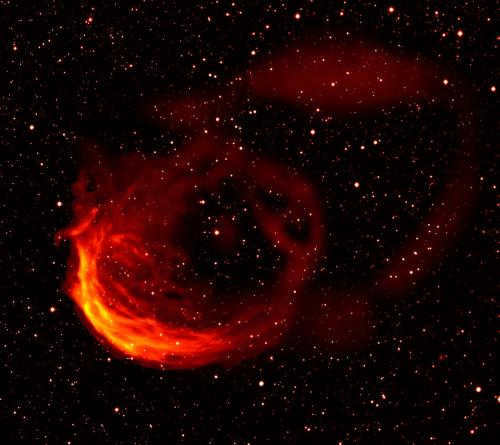
The nebula Sharpless 2-188, which bears a resemblance to the logo of the Mozilla Firefox browser, is an intriguing celestial object.
Most of these fascinating objects can be easily observed using just a basic pair of 7×35 field binoculars. When scanning the area of the sky occupied by the well-known asterism “W”, many of these star clusters will come into view. Some clusters immediately stand out with their brightness, while others may be more subtle due to their smaller number of stars, requiring the use of a map for identification. It is interesting to note that Charles Messier only included two of these objects in his catalog, which are now known as M52 and M103. Let’s take a closer look at these two clusters.
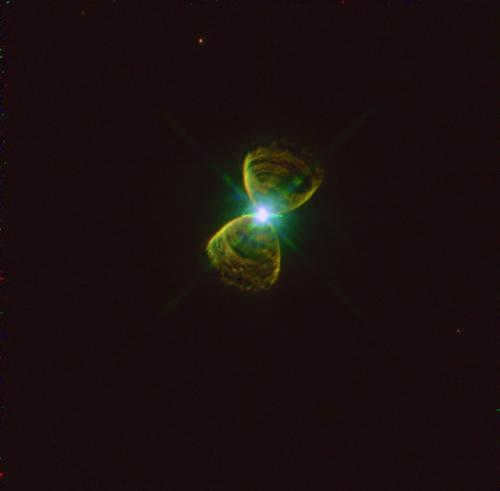
Orion Constellation: Myths and Legends
The constellation Orion has been associated with numerous stories, myths, and legends. Different cultures have interpreted its appearance in the sky in their own unique ways, leading to various names for the constellation across the world. The Greeks connected it to their gods, while in Egypt, it was known as the King of Stars. In Armenia, it was named after a legendary figure – Hayk, the patriarch and ancestor of the Armenians. Interestingly, many civilizations only identified the belt of Orion and gave it names like Three Sisters, Three Women, Three Men, Three Plows, and so on, without considering the other stars in the constellation.
However, this constellation is not only famous for its stories from ancient times. In the modern era, there is a widespread belief that extraterrestrial civilizations will come from the Orion belt. One of the reasons for this belief is the fact that some of the stars in Orion are larger and more luminous than our own Sun. Take a look at the Orion constellation. You can find photos of it from various angles in this article. Who knows, you might even get the feeling that there are other civilizations out there.
In the compact constellation of Cassiopeia lies a plethora of captivating celestial entities. If you possess a telescope or a pair of binoculars, you can indulge in hours of exploration during autumn nights, marveling at the dispersed star clusters and binary stars that grace this celestial region. However, even without any optical aids, there is an abundance of visual wonders to behold. Among the primary allures of this constellation resides the remarkable gamma star of Cassiopeia.
It is common knowledge that the Cassiopeia constellation resembles a W in the Latin alphabet. The luminosity of the stars forming this shape is approximately the same as that of the stars in the Ursa Major constellation. However, it is unclear which of the five stars is the most brilliant.
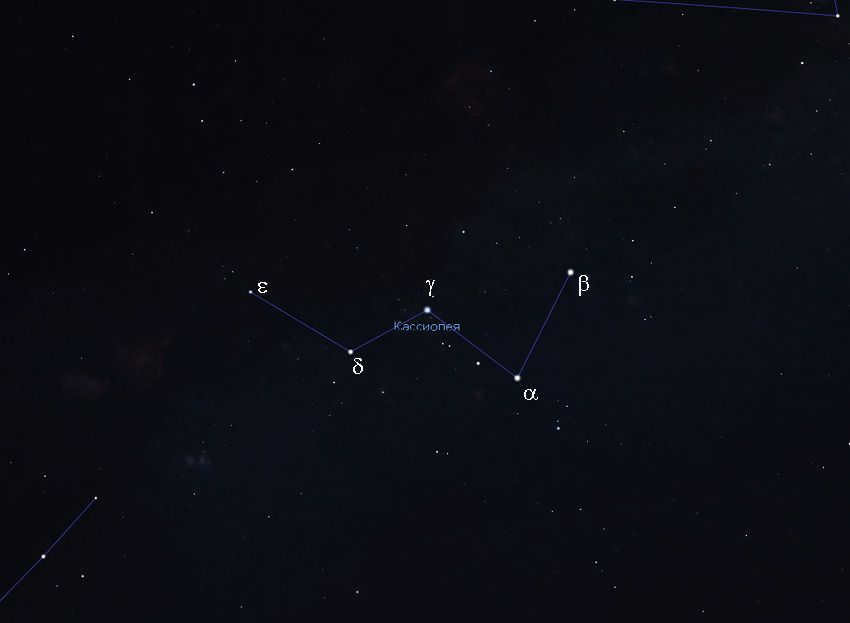
The primary star of the constellation Cassiopeia is the focal point of the constellation’s shape, which bears a resemblance to an inverted M or the letter W in the Latin alphabet. Image: Stellarium
The solution is not as straightforward! If you closely observe the stars of Cassiopeia, you can easily determine that the first two stars in Figure W (when viewed from left to right) are noticeably less bright compared to the other three. However, among the remaining three stars, which one is the most luminous? In the currently widely accepted V photometric system, the most luminous star is the gamma (γ) of Cassiopeia. the star at the center of the W. With a luminosity of 2.15 m, it is only 0.05 magnitude brighter than the adjacent star, alpha Cassiopeia. Similarly, Cassiopeia’s alpha is another 0.05 m brighter than beta Cassiopeia, the star located on the right side in figure W.
A new and unique gamma-ray star in Cassiopeia.
When scientists discovered spectral analysis in the 19th century, astronomers immediately recognized that studying the spectra of stars would provide valuable insights into the chemical makeup of these distant celestial bodies. Angelo Secchi, a Catholic priest and astronomer, was at the forefront of astronomical spectroscopy. He examined the spectra of stars and became the first person in history to experimentally confirm that the Sun is a star. When Secchi observed the spectrum of gamma-ray emissions from Cassiopeia, he anticipated seeing dark absorption lines indicative of various chemical elements, similar to what is observed in the spectra of the Sun and other stars. However, to his surprise, he observed numerous bright lines instead!
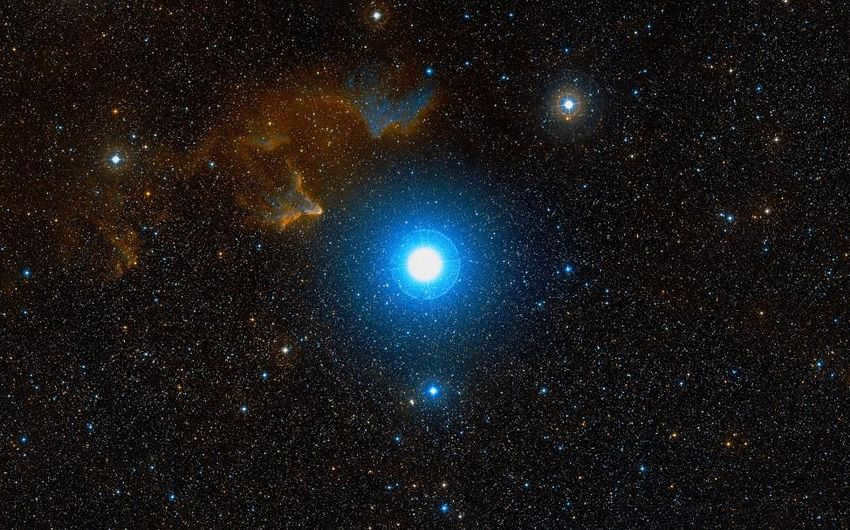
Cassiopeia’s gamma-ray star. Photo: Sky-map.org
This finding generated a great deal of interest among astronomers. The vibrant streaks in the spectrum were referred to as emission lines, indicating the emission of light. The most likely explanation was that these lines were indicative of the intense movement of hot gases across the surface of the star.
Subsequently, it was discovered that Cassiopeia’s gamma-ray star was just one of numerous stars of its kind. It served as the flagship of an entire category known as Be stars. In this context, the “B” represents the temperature class of the star in Latin, while the “e” signifies the presence of emission lines in its spectrum.
All Be stars are massive luminous objects with surface temperatures ranging from 10,000 to 30,000 degrees Celsius. They are known for their unpredictable and abrupt fluctuations in both light intensity and spectral properties. It seems that these stars undergo episodes similar to explosions, ejecting clusters of extremely hot plasma into the surrounding space. This unique behavior classifies them as members of the eruptive (or “explosive”) variables subgroup, which is also referred to as new-like stars.
γ Cassiopeia: A Brief History
Prior to 1927, γ Cassiopeia was merely recognized as a peculiar star displaying emission lines. However, a pivotal transformation occurred that year, as this star not only experienced alterations in its spectrum, but also in its luminosity. By 1935, its luminosity multiplied by 2.5, ultimately reaching a magnitude of 1.6. Consequently, γ Cassiopeia ascended to the ranks of the 25 brightest stars visible in the sky! This remarkable development suggests that astronomers bore witness to a substantial eruption: the luminary’s atmosphere expanded, and a portion of it permanently departed the star.
Following that, the brightness of the star decreased to 3 m Since then, Gamma Cassiopeia has not experienced a similar eruption, but it has consistently exhibited noticeable smaller changes in amplitude. Here is a chart illustrating the star’s varying brightness over the past 60 years. Each data point on the chart represents the average brightness of Cassiopeia gamma over a period of ten days.
The visual representation of the light curve for Cas AAVSO gamma from 1960 until the present. It is worth noting that there may be horizontal lines in certain parts of the light curve. These horizontal “lines” are in fact densely concentrated individual observations. Source: AAVSO
Distinguishing Features of Stars like Gamma Cassiopeia
What sets stars such as γ Cassiopeia apart from the Sun and other Main Sequence stars? As previously mentioned, these stars are both massive and hot. However, they also exhibit remarkably fast rotation on their axis, reaching equatorial speeds of up to 450 kilometers per second. This rapid rotation leads to the elongation of the star at its equator, giving it a melon or rugby ball-like shape. The intense radiation emitted by B-stars (which are thousands of times brighter than the Sun) creates a phenomenon known as a “stellar wind”, resulting in the formation of a flat disk of hot gas along the equator in these stars. In the case of Cassiopeia gamma-ray stars, which are a type of B-star, the disk is observed from its edge, causing the plasma within the disk to generate deep, narrow absorption lines.
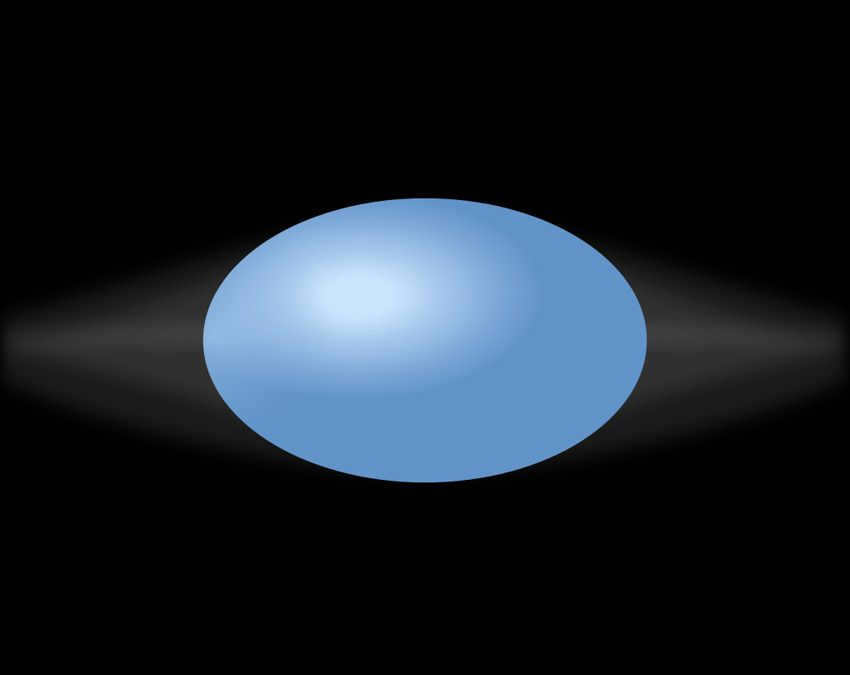
This is the appearance of typical Be stars when viewed from a different angle. Reference: Wikipedia
Currently, astronomers have the ability to observe such disks using advanced optical interferometers – two or more telescopes that simultaneously observe an object. Over time, these shell disks are eventually lost by the stars. The expansion of gas causes an increase in the apparent brightness of the star. However, the gas eventually dissipates and the star’s luminosity returns to its original value.
Observations of Gamma-ray Eruptions in Cassiopeia
It remains uncertain whether future outbursts similar to the 1935 eruption will occur in γ Cassiopeia. However, it is beneficial and straightforward to monitor this particular star. For comparison, consider the two stars in Cassiopeia, delta (δ) and beta (β). Additionally, include the gamma star of Andromeda, known as Alamac, and optionally the alpha star of Perseus, named Mirfak.

The Cassiopeia constellation’s surroundings. The beta and delta of Cassiopeia, the gamma of Andromeda, and the alpha star of Perseus, Mirfak, are shown as comparison stars. The luminosity of the comparison stars is indicated in stellar magnitudes. Image: Stellarium
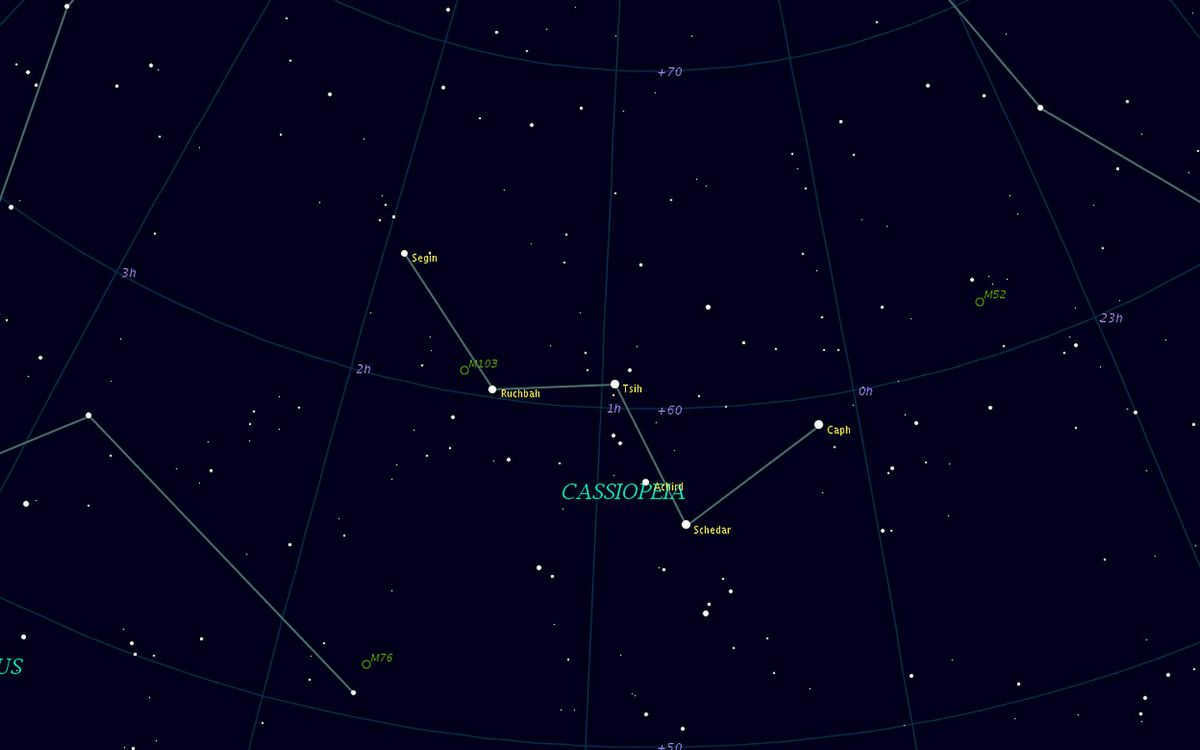
Cassiopeia is the prominent celestial pattern in the northern hemisphere
On a clear night, you can witness a mesmerizing display of stars in the sky. These stars come together to form intricate shapes and patterns. The brightness and color of these stars vary, with different temperatures determining their hues.
The coldest stars appear red, while the hottest ones have a bluish tint. The temperature of white and blue stars is even higher than that of the Sun, which is classified as a yellow star.
Throughout history, humans have been fascinated by the celestial phenomena that adorn the night sky.
Even in ancient times, astronomers observed the relative positions of celestial bodies and their groupings.
These groupings were known as constellations and were named after various mythological figures and legends.
Constellation Cassiopeia’s Location
Cassiopeia, an intriguing constellation, resides in the northern hemisphere of the sky, captivating astronomy enthusiasts.
Following the Great Bear and the Little Bear, it holds the third spot in terms of navigational significance, encompassing a space of only twenty-fifth rank. Its occupied area measures five hundred and ninety-eight and four-tenths square degrees.
The prominent stars of the Pleiades create a cluster known as the “close company” or the asterism1 Throne, resembling the shape of the letter “M” or the English “W”.
Astronomer Ptolemy was the first to chart this constellation in the second century.
There are approximately 150 visible luminaries in this celestial object. Most of them are located within the Milky Way. It is surrounded by the constellations of Andromeda, Giraffe, Perseus, Cepheus, and Lizard.
It is particularly intriguing for astronomers due to the presence of various star clusters.
This celestial object was named after the queen of Ethiopia.
Legends and myths connected with the constellation Cassiopeia
Once upon a time, there was a queen who was so proud of her beauty that she insulted the sea nymphs who surrounded her. This behavior angered Poseidon, the god of the sea. As a punishment, he placed the queen in a basket and made it spin around the pole. Every so often, the basket would flip upside down, causing the queen to experience a terrible headache. This was the punishment given to the vain woman.
In his atlas, Claudius Ptolemy transformed the basket into a majestic throne, showing compassion for Cassiopeia.
There is another tale associated with this constellation.
There existed a magnificent land on the surface of the planet, situated on its southern hemisphere. It was under the rule of King Cepheus, a widely renowned figure for his exceptional intelligence, alongside his exquisitely beautiful queen, Cassiopeia. Their precious daughter, Andromeda, was nurtured and cherished by the unconditional love and tender care provided by her parents. Throughout her carefree childhood, she was surrounded by peculiar blossoms and the melodious songs of birds.
As time progressed, she blossomed into a stunning maiden.
Her mother persistently showered praises upon her daughter’s beauty, while never neglecting to acknowledge her own. She specifically pointed out that the beauty possessed by the nymphs dwelling within the depths of the sea could not hold a candle to their own. Amphitrite, in particular, was the focus of these words.
These remarks deeply saddened the nymphs. They urgently sought assistance from Poseidon, the mighty god of the sea, who happened to be Amphitrite’s husband. Consumed by furious wrath, the god resolved to punish the insolent ruler.
In order to execute his plan, he dispatched the monstrous sea creature, Kit, to annihilate Cepheus’s kingdom.
In the face of the horror, the ruler embarked on a quest to find solutions to save both his country and his family. He sought out the oracle for guidance, pouring out his tale of misfortune and receiving in return the advice that the only way to secure salvation was to sacrifice his own daughter.
For a considerable length of time, the parents grappled with the decision to give up their child to be mercilessly torn apart. However, the moment eventually arrived when they brought Andromeda to the seashore and bound her to a rock.
It was during this time that Perseus, mounted on his Pegasus, was returning home. On this particular occasion, he had emerged victorious in a battle against the monstrous Gorgon jellyfish. As he laid his eyes upon the captivating maiden, he was overcome with love for her. In order to liberate the captive, he would have to confront the sea monster head-on. Utilizing the severed head of the jellyfish as a weapon, he transformed his adversary into an enormous stone.
Everyone was filled with joy and made preparations for the grand celebration of the wedding. However, when she was still a young girl, the stunning maiden was promised to be married to Phenaeus. Upon learning of this arrangement, he arrived with a troop of soldiers to claim his future bride. Nevertheless, Perseus emerged victorious in the ensuing battle.
For his triumph, he was granted not only a wife but also half of a kingdom. Following the wedding, they did not remain at home but embarked on a journey together.
Furthermore, the gods immortalized all the brave heroes in the heavens. As a consequence of her excessive pride, the queen is suspended upside down once a year. This punishment causes her to experience severe dizziness.
The prominent stars in the constellation of Cassiopeia.
The majestic ruler’s extended seat consists of five most luminous stars that create a zigzag pattern resembling the letter W or M – these are Rukbach, Seguin, Navi, Kaf, and Shedar.
The star named Rukbah (double) is derived from Arabic word for knee. It is a white giant star, ranking fourth in terms of brightness, and located at a distance of ninety-nine light years. With a radius four times larger than the sun, it shines 68.56 times brighter than the sun. The surface temperature of this star is eight thousand five hundred degrees Kelvin.
According to Ptolemy’s descriptions, the combination of Saturn and Venus properties can be observed. In a modern interpretation, it is associated with the element of fire. Those who are born under this sign have inherent creative potential and determination.
It is important to direct these talents towards benefiting others, as unwarranted arrogance can result in severe moral harm.
Shedar, an orange giant that is brighter but colder than the sun, holds a significant position in the heart of Cassiopeia. Its name means “breast” in Arabic. It is located approximately 228 light years away from the sun and is estimated to be 200 million years old. Shedar has a diameter 42 times larger than the Sun and is believed to be a variable star.
Australian astrologer Bernadette Brady associates this celestial body in people’s horoscopes with feminine power and the potential to become a strong individual who inspires respect.
Wisdom and intuition. These characteristics should be demonstrated in a positive manner. It is a source of strength and dignity.
The Seguin, a white-blue giant, is approximately fifteen million years old. Its distance is estimated to be four hundred and thirty light years. It has a mass nine times greater than the sun and a radius six times larger. The temperature is 15174 degrees.
The Seguin possesses the qualities of both Mercury and Saturn. According to the theory proposed by D. Kutaleva, it corresponds to the element of air. Individuals born under its influence must carefully consider their actions. They have the ability to convey information to the masses, even if society is not yet ready to accept it. However, this knowledge can also be used against them.
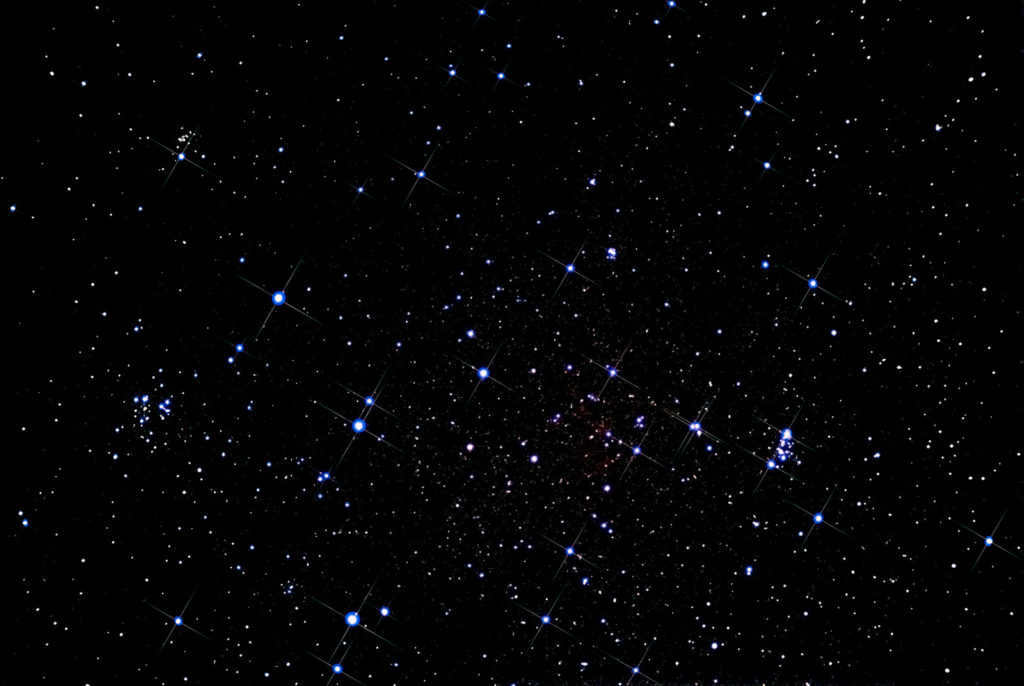
Above the throne, in the drawing, we can see Cassiopeia sitting on her thighs.
This blue star is situated 610 light years away. It possesses a brightness that is 40,000 times greater than that of the sun and has a mass equivalent to 15 solar masses.
Its rotation period is 204 days.
In China, it is known as Qih, which translates to “whip”. Astronaut Virgil Grissom gave it the nickname “Navi” after reversing the name Ivan.
Astronauts used it as a point of reference during their missions.
In modern theory, it is associated with the element of air. Being born under this sign grants a person a flexible mind and a philosophical way of thinking. These qualities are essential for carrying out important tasks, but they should not be glorified excessively.
Kaf is a subgiant that appears yellow-white and is located in the W asterism. Its Arabic translation is “palm,” which refers to its position near the Pleiades. Kaf is located approximately 54.5 sv years away from us and is twenty-eight times brighter and four times larger than the sun. Currently, it is undergoing the cooling process, but it has the potential to evolve into a red giant in the future.
In the system theory, Kaf is associated with the element of earth and is linked to Mercury.
Kaf embodies a sense of exceptionalism, granting those born under its influence a sense of superiority over others. Individuals born under Kaf possess impressive abilities and practical skills, often making them informal leaders. However, they rarely achieve a significant material position.
The closest yellow-white hydrogen dwarf star to our solar system is affectionately nicknamed Ahird. It has a surface temperature of 5,730 degrees Kelvin.
Zeta Cassiopeia is a subgiant star that emits a blue-white light. It is located approximately 600 light years away from us. This star is known for its variable nature, meaning that its brightness fluctuates over time. Additionally, Zeta Cassiopeia possesses a magnetic field. The star completes one full rotation every 5.37 days.
Rho Cassiopeia, on the other hand, is a hypergiant star with a bright yellow appearance. It is situated at a much greater distance of 11,650 light years from Earth. Interestingly, Rho Cassiopeia is so luminous that it can be observed without the need for any technical equipment. In fact, it is about five hundred and fifty thousand times brighter than our Sun. Every fifty years, this star experiences massive bursts of energy. During these bursts, it ejects approximately ten thousand times the mass of Earth. Scientists speculate that if Rho Cassiopeia were to explode like a supernova, the light from the explosion would take a significant amount of time to reach us.
Lastly, Cassiopeia is also home to the yellow-white variable star known as V509. This star is classified as a supergiant and is located at a distance of 7800 light years from us.
Celestial objects in the constellation of Cassiopeia
In 1572, a new star appeared in the sky and it was observed in Korea. Two days later, it was also noticed in China.
On November 11, 1572, the renowned Danish astronomer Tycho Brahe made an observation of a bright ball in the constellation of Cassiopeia during the evening. This celestial object had no tail and was surrounded by nebulae. Its appearance resembled that of a first magnitude star.
The brightness of this object was comparable to Venus. It was easily visible during the day with clear skies and perfect visibility, and it could even be seen at night through thick clouds.
Tycho Brahe deduced that this object was much farther away than the Moon. He regularly compared its brightness to that of Jupiter and other nearby stars to estimate its brilliance. The object remained stationary in the sky.
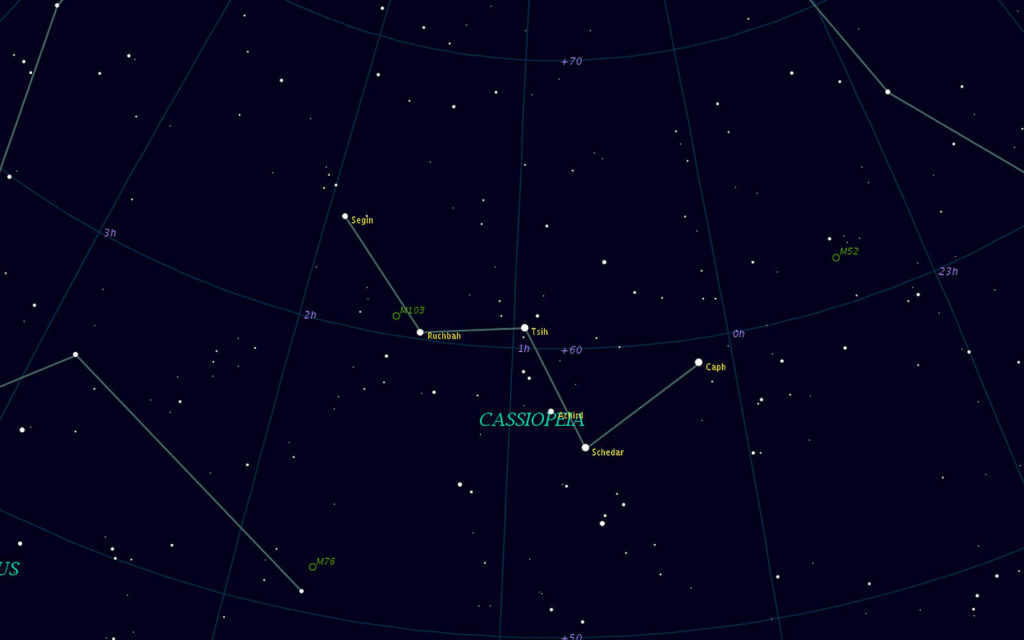
His book “Essays on New Astronomy” contained the findings from his observations in 1602.
In 1952, a source of radio emissions was discovered at the location of the outburst.
A supernova remnant was discovered in the optical range in 1960.
It is commonly referred to as the Tycho Brahe supernova. The remnants of the collapsed star emit gamma rays.
In 1774, Charles Messier discovered a diffuse cluster that featured two prominent yellow giants. Due to its high apparent magnitude, it is visible through binoculars. The cluster is estimated to be thirty-five million years old and has a diameter of nineteen light years. The M52 cluster was discovered five thousand light-years away.
In 1783, the White Rose placer was discovered by Caroline Herschel. Using a telescope, she observed a whirlpool of many small stars swirling. It is known as the “Saucer” in Russia.
NGC 457 is a scattered cluster that resembles an owl with fiery eyes and spread wings.
In astrophotographs, two nebulae are clearly visible within the cluster.
One of them is a distorted, inflated bubble that was first observed by William Herschel in 1787.
This nebula was formed by the stellar wind of a massive hot star approximately 300,000 years ago.
It has a diameter of seven light-years and is fifteen times the radius of the sun.
The second nebula resembles an open-mouthed kolobok and is nicknamed Pac-Man, after the popular computer game character.
The distance to the nebula is calculated at 10,000 light-years. The nebula spans a length of 130 light-years. Inside, there are structures composed of dark, dusty material.
How to locate the Cassiopeia constellation in the night sky.
Located nearby is the Dragon constellation, which features an angled house. This peculiar house has no windows or doors and is inhabited by King Cepheus. Sitting close to him is a maiden who holds a mirror. This proud maiden is none other than Cassiopeia, the wife of King Cepheus.
In the night sky, Cassiopeia can be found as an asterism in the shape of a Throne. This pattern is easily visible with a single glance. If you step outside at midnight during early autumn, you will see it directly above your head. By accurately determining the angular dimensions, you can mentally connect the stars to form the constellation.
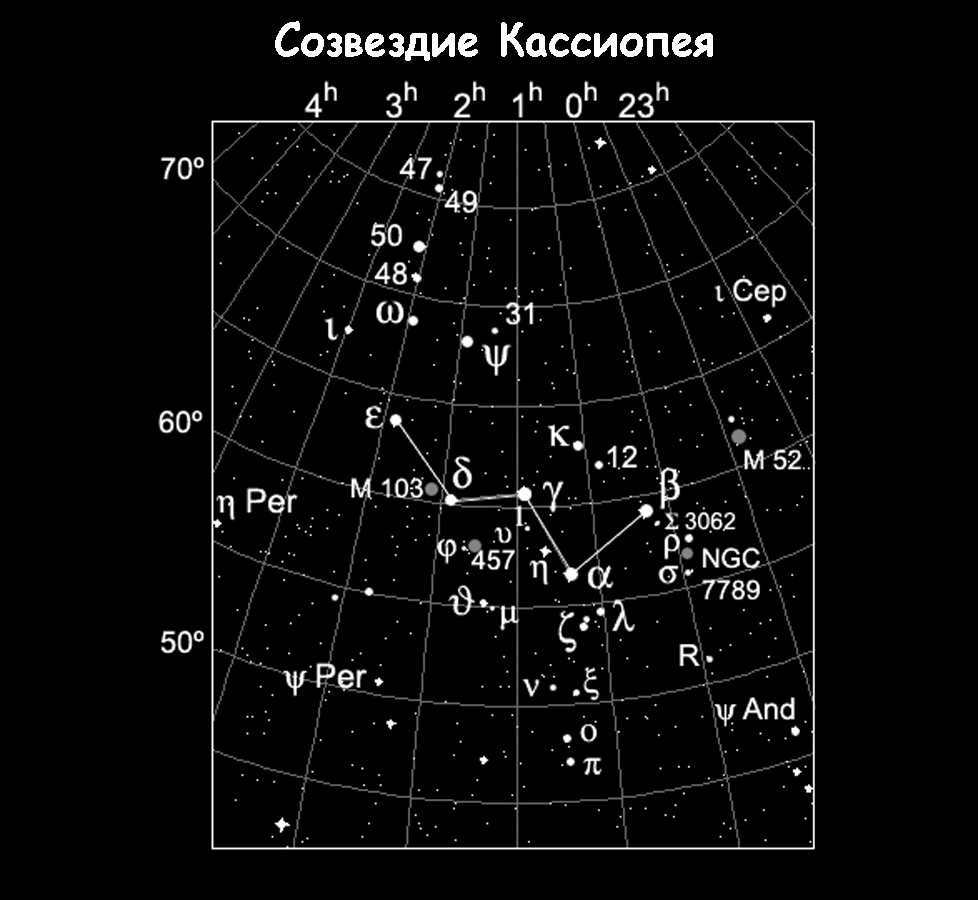
The letter “W” is one of the 88 letters of the celestial alphabet and Queen Cassiopeia never sets over the horizon.
Where and how to witness the constellation


A representation of the constellation Cassiopeia
The constellation Cassiopeia can be seen throughout the year in the middle latitudes of the Northern Hemisphere. However, the best time for observing it is during the autumn when it rises high in the sky and reaches its zenith. This optimal viewing period extends until the end of winter.
The primary celestial bodies of the star grouping include
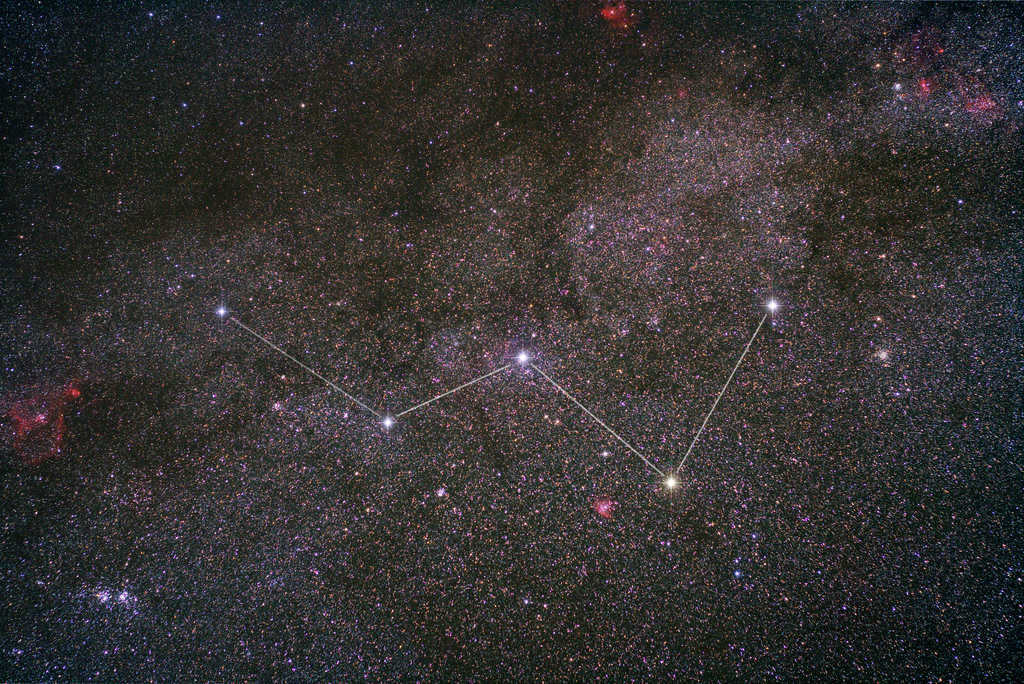
The distinct and easily identifiable shape of Cassiopeia, resembling the letter “W” in the Latin alphabet, is created by the prominent stars within the constellation: α, β, γ, δ, and ε Cas. These stars possess similar levels of brightness, with magnitudes ranging from 2 to 3m.
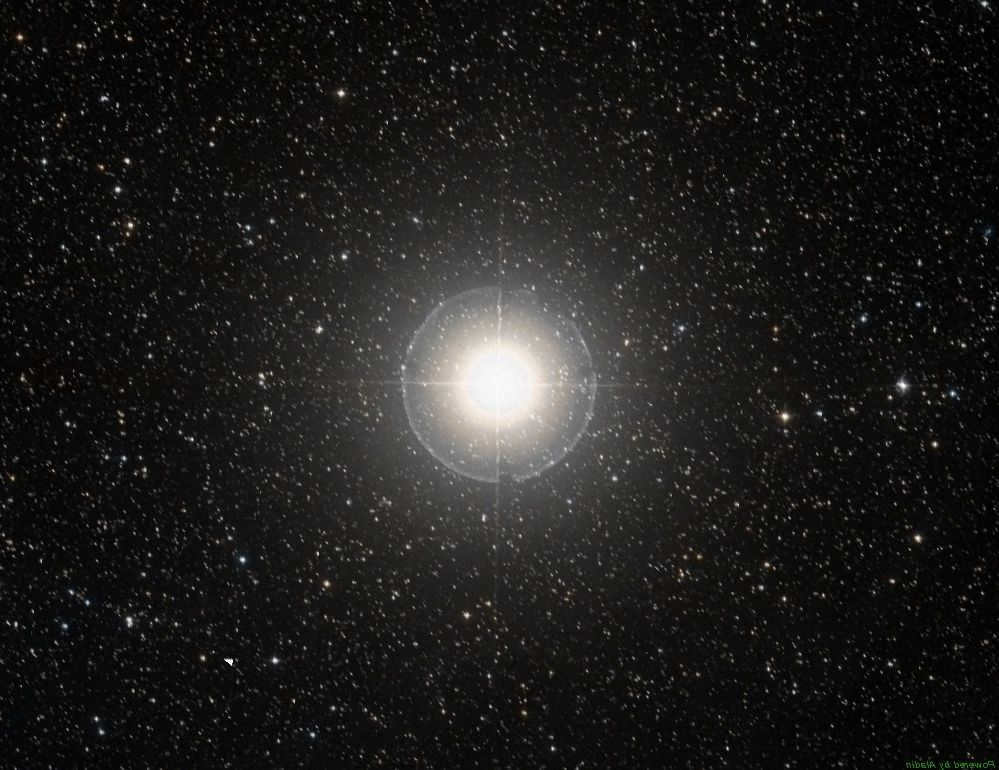
Image of Shedar or alpha Cassiopeia
The most luminous star in Cassiopeia is α Cas or Shedar, with a stellar magnitude of 2.2. Navi, γ Cas, is a star that varies in brightness, with its magnitude ranging from 1.6 to 3 over a span of approximately 50 years.
Astronomical Entities and their Descriptions


The Cassiopeia constellation is completely immersed in the summer Milky Way, indicating that it is likely to contain many distant objects. Cassiopeia is home to over twenty impressive diffuse star clusters, making it an ideal target for powerful astronomical binoculars or a high-power refractor with a minimum aperture of 100 mm and a wide field of view.
One notable object in Cassiopeia is the Sharpless 2-188 nebula, which bears a resemblance to the logo of the Mozilla Firefox browser.
Most of these items can be seen using even the simplest 7×35 field binoculars. When observing the portion of the sky occupied by the asterism “W”, many of these clusters will come into view. Some of them are immediately noticeable, while others may not be easily seen at first due to their small number of stars, even with the help of a map. Interestingly, Charles Messier only included two of these objects in his catalog. They are now listed as M52 and M103. Let’s take a closer look at them.
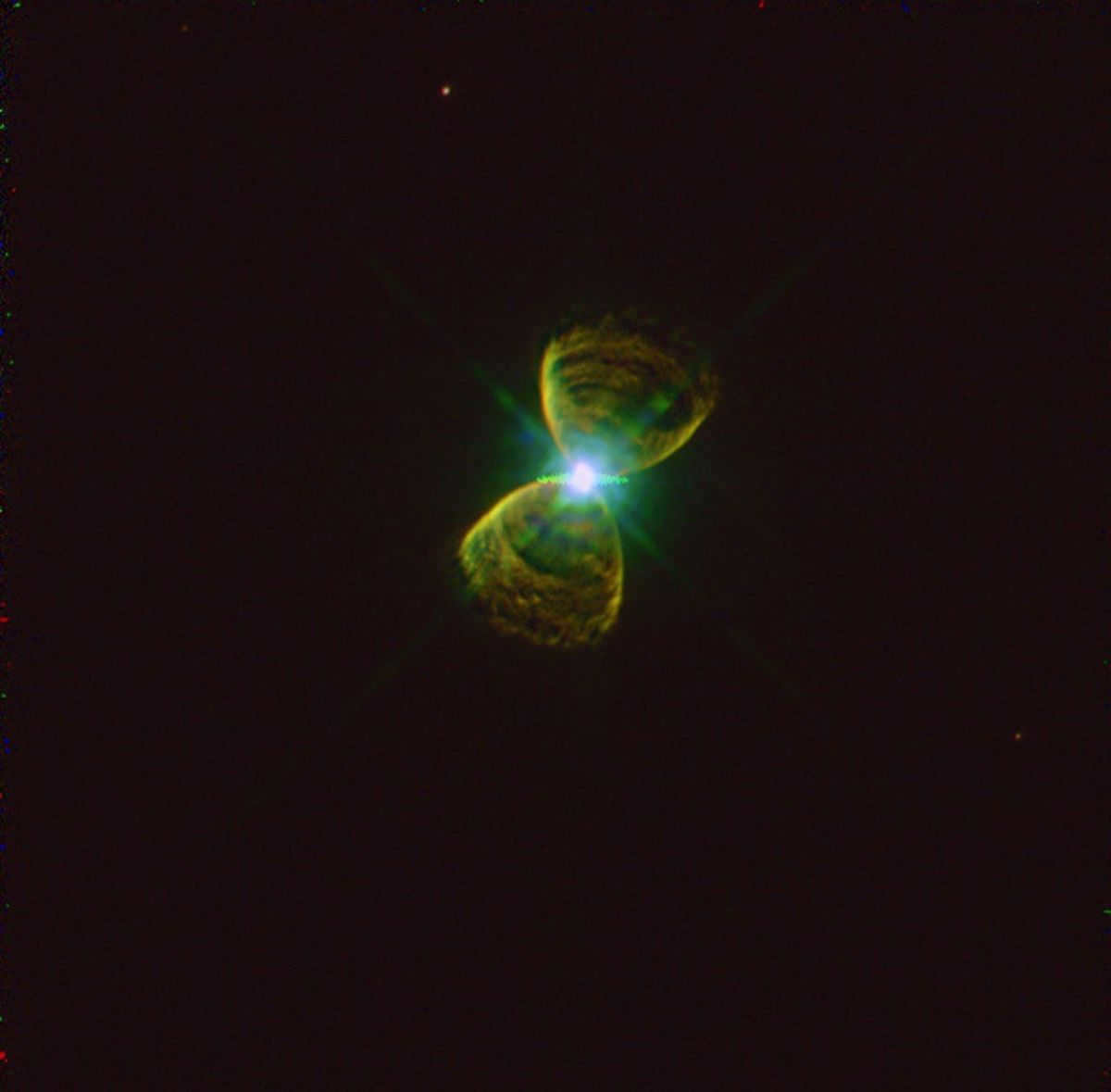
Here is a picture of the planetary nebula PK111-2.1 located in the constellation Cassiopeia.
The scattered cluster M52
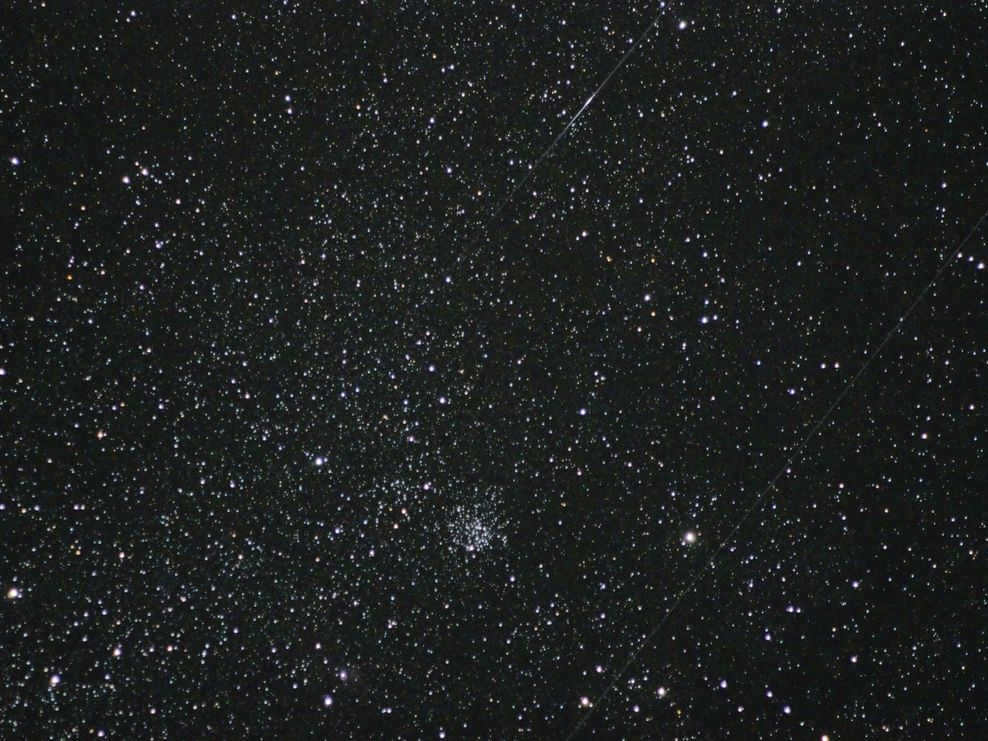
If we extend the line connecting the stars α and β Cas at an equal distance to the NNW, we will come across the scattered cluster M52. When observed through medium binoculars, it appears as a luminous and shimmering haze, almost round in shape, with about a dozen stars shining within it, arranged in two distinct chains. One chain resembles an inverted “U”, while the other chain forms a “V”.
M52 observations
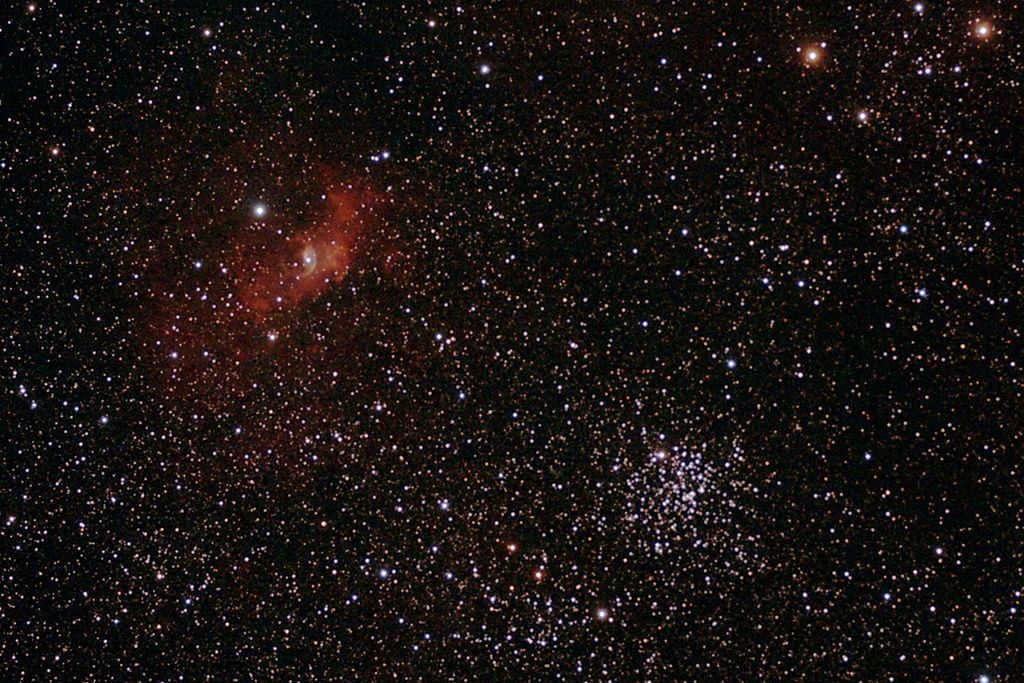
Photo of the M52 cluster and the Bubble Nebula
When observing through a telescope, the M52 cluster and the Bubble Nebula appear as a bright and diffuse cluster. In the search eyepiece, you can see around two dozen stars that form the shape of the letters “U” and “V”. These stars create a beautiful contrast against the sparkling fog of unresolved luminaries. At the southwestern tip of the cluster, there is a bright star with an approximate brightness of 7-8 stellar magnitudes. When increasing the magnification to 40-50x, a slightly compressed spot becomes visible from the northeast. In this area, there are more than two dozen flickering stars, whose brightness fades as you move towards the outer edges of the cluster.
M103
can be paraphrased as “M103 course”.
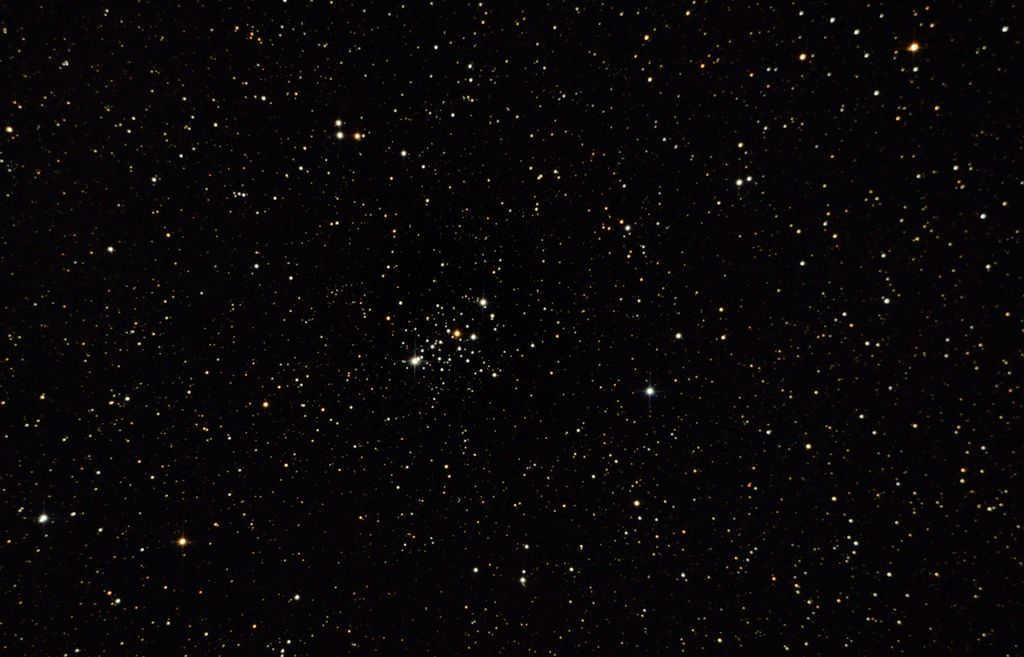
Photograph of Cluster M103 or NGC 581
Located in the vicinity of Rukba (δ Cassiopeia), approximately one degree east-northeast of it, we come across the final celestial object within this constellation, first observed by Ch. Messier. At one point, it held the distinction of being the last entry in his catalog (the remaining objects, up to M110, were subsequently added in the twentieth century from unpublished notes by Messier). The esteemed astronomer himself simply referred to this object as a rather ordinary “cluster of stars,” a description that does not fully capture the essence of this extraordinary “stellar dwelling.”
Observations of M103
Observing M103
M103 is a star cluster located in the constellation Cassiopeia. It is a beautiful sight to behold, with its bright stars and dense concentration of stellar bodies. In order to observe M103, you will need a telescope with a moderate to high magnification power. Look for it in the northeastern part of the constellation, near the star Eta Cassiopeiae. The best time to observe M103 is during the winter months when the constellation is highest in the sky.
When observing M103, take note of its overall shape and size. It has a triangular form, with a bright star at its apex and several fainter stars forming the base. The cluster is composed of around 172 stars, with the brightest ones having a magnitude of around 7.6. It is estimated to be around 9,500 light-years away from Earth.
Take your time when observing M103, as it is a complex and intricate object. Use different eyepieces to get different views of the cluster and try to observe it under different sky conditions. You may also want to sketch what you see to better understand its structure and composition.
Overall, observing M103 can be a rewarding experience for amateur astronomers. Its unique shape and beautiful star composition make it a fascinating object to study and admire.
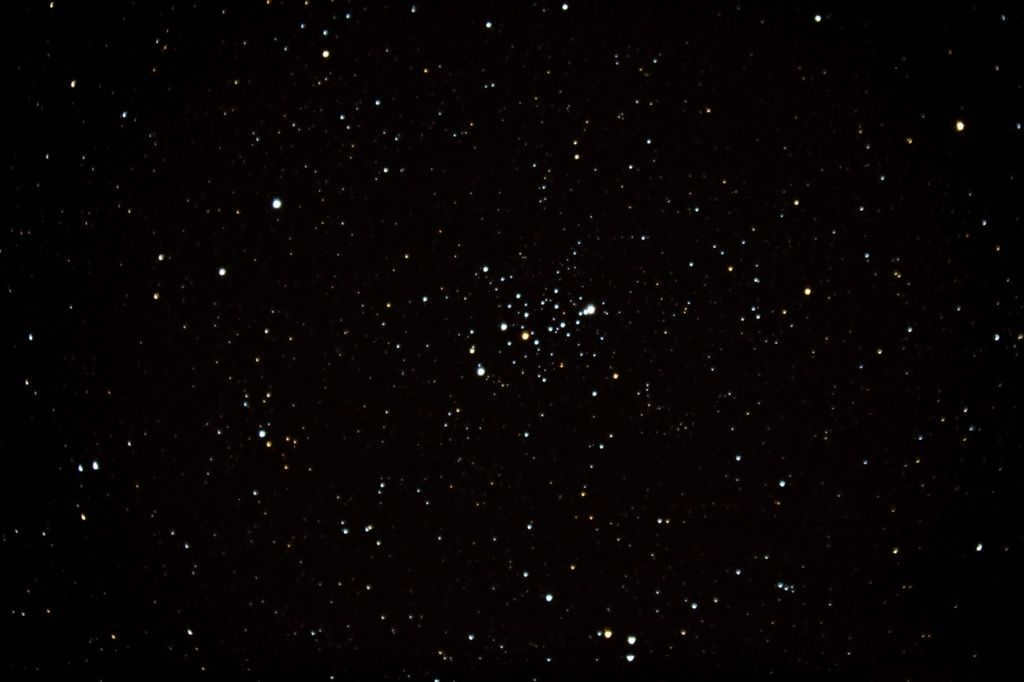
Image of Scattered cluster M103
Even with a pair of small 7×35 commander’s binoculars, one can easily locate a small cluster of dazzling stardust. If the same binoculars are securely mounted, one can observe a distinctive asterism within the cloud, which is not directly associated with the cluster but is the most prominent feature visible through the binoculars. This asterism is known as the multiple star Struve 131, consisting of individual stars arranged in a pattern that resembles an arrowhead, with the brightest star positioned at its tip.
NGC 654, 659, and 663: A Closer Look at Stellar Clusters
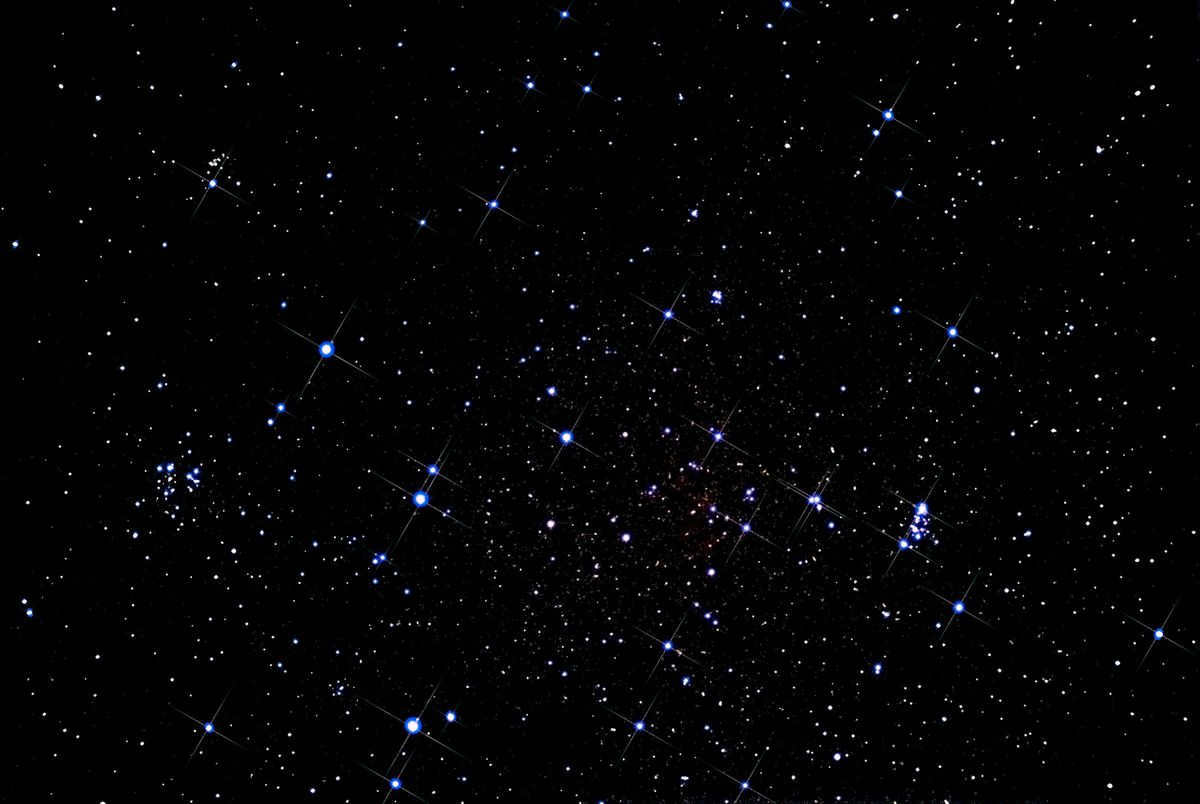
A picture shows scattered clusters NGC663 (in the middle left), NGC 659 (in the bottom left), NGC 654 (in the top left), and Messier 103 (on the right and below center).
Within a distance of less than two degrees along the east-northeast extension of the δ Cas – M103 line, which can easily fit into the same field of view, there are three neighboring scattered clusters, namely NGC 654, NGC 659, and NGC 663. Together, they form an isosceles obtuse triangle in the sky, providing observers with the opportunity to compare them with each other. NGC 654 is a small cluster with few stars, and it can only be counted around a dozen stars of 8 – 9 magnitude. NGC 659 is also not particularly beautiful, but their neighbor in the sky – NGC 663 – is an impressive object.
NGC 663: A Closer Look
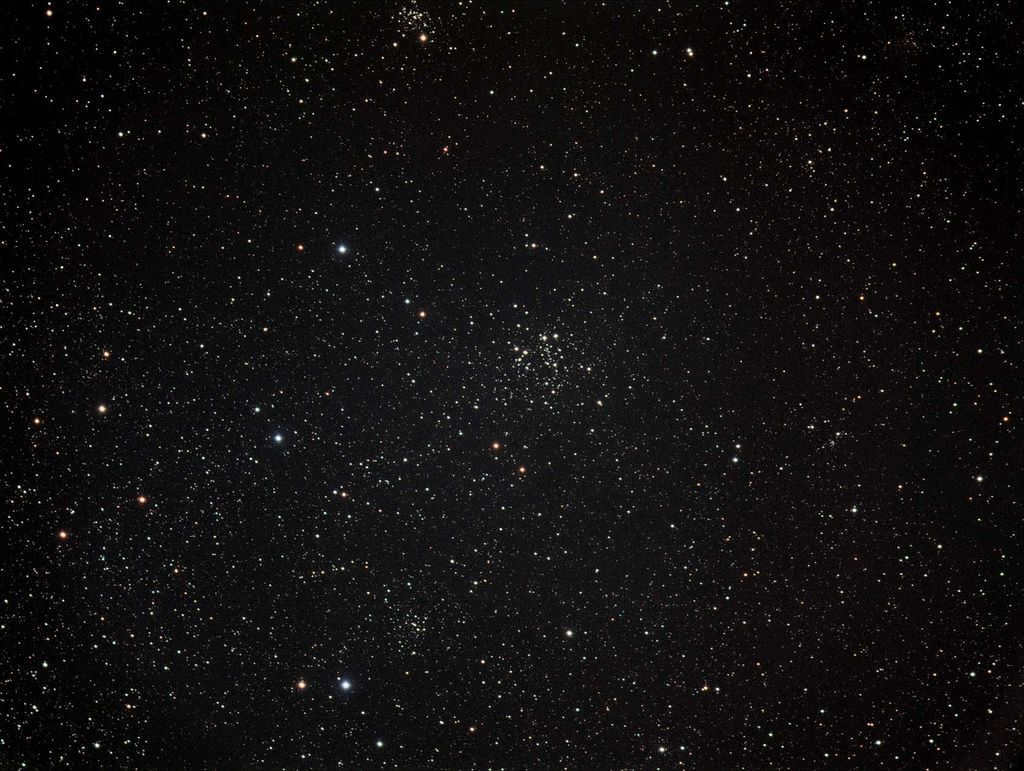
Therefore, when using a small and fast refractor or powerful astronomical binoculars, one can observe a cluster of stars in the constellation Cassiopeia. This cluster consists of more than twenty stars, which are surrounded by a sparkling fog. By increasing the magnification, it is possible to detect a few more stars that are added to the cluster. It is worth noting a unique characteristic that is not immediately noticeable – the unresolved mass of the cluster is located right at its center, while the outer region consists mainly of resolved stars. This peculiar feature is only apparent when observing with small telescopes, and it is less noticeable in other cases.

Join me on a journey from the beginning to the end of the “W” section of Cassiopeia, where we will explore various fascinating objects. Our first stop is NGC 457, located to the northeast of δ Cassiopeia. Next, we will visit NGC 225, which can be found strictly to the east of γ.
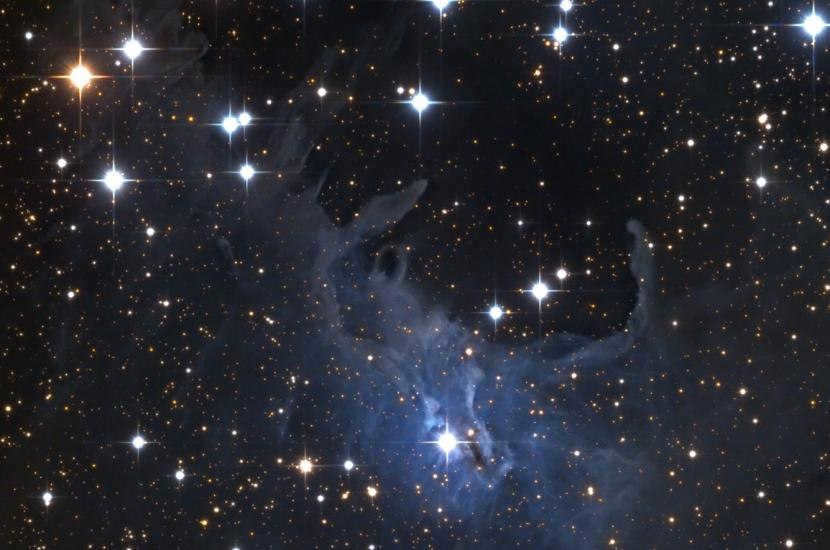
Image of the VdB 4 nebula and NGC 225
The VdB 4 reflection nebula is connected to the dispersed star cluster NGC 225, which is also known as the Sailboat or Broken Heart.
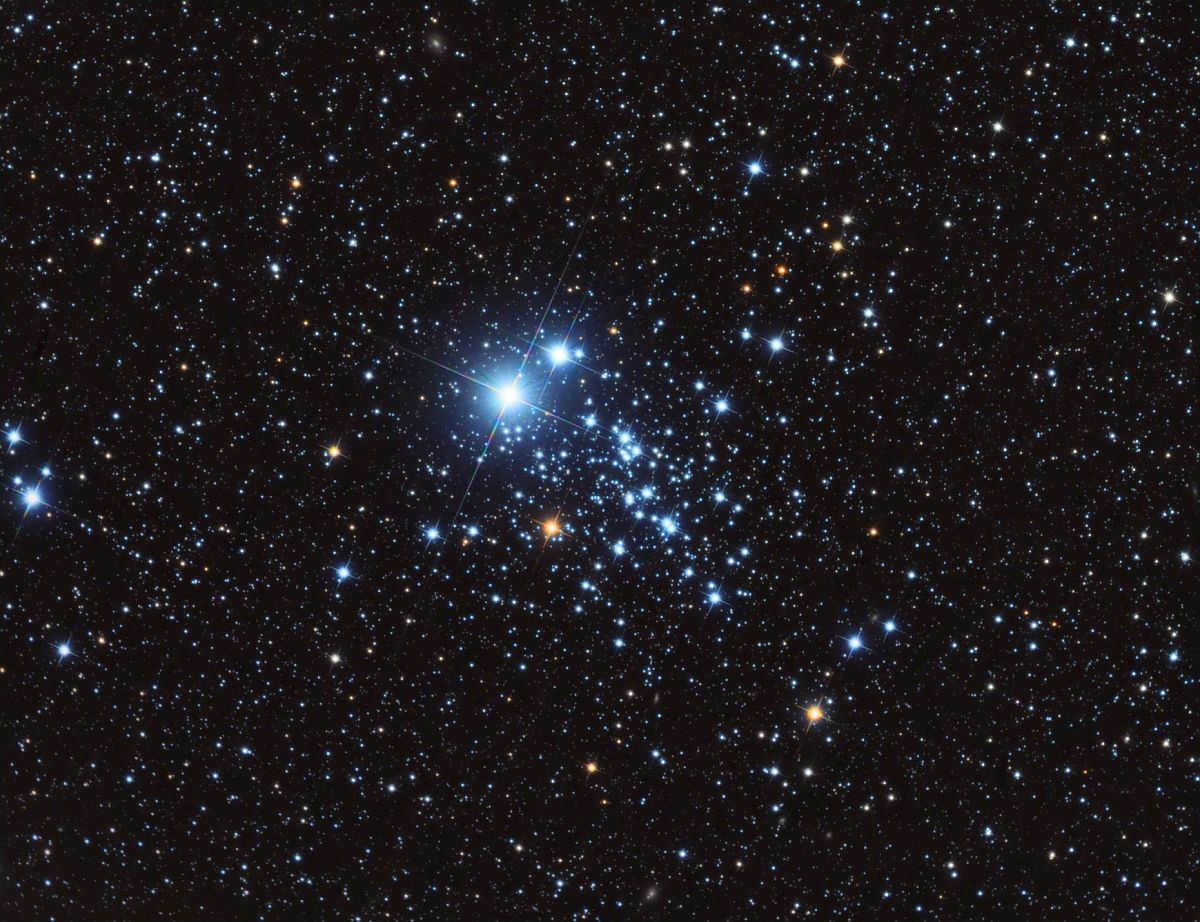
Image of NGC 457 – dispersed cluster
We must not overlook two significant entities such as NGC 129 and NGC 281, both of which possess an almost 6th magnitude star. NGC 281 is also known as the Pacman Nebula.

A picture of NGC 281, which is an emission nebula located in the constellation of Cassiopeia.
However, let’s shift our attention to another interesting object, NGC 7789.
NGC 7789
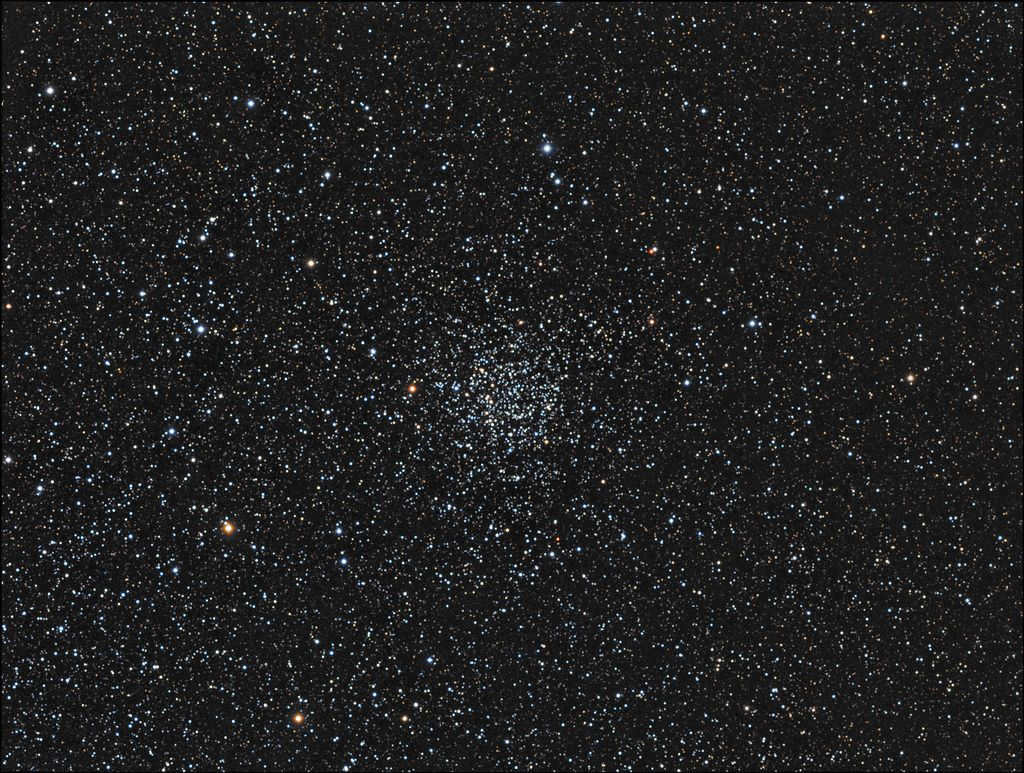
Also discover it by shifting your view slightly to the West from Shedar. Right between the stars ρ and σ Cas, you will locate NGC 7789. This cluster is quite luminous and scattered, with a magnitude of 6.7 stars. You can observe it with any optical instrument, whether it be a telescope or a 10-inch or larger telescope.
NGC 7789 observations: a closer look at the celestial wonder


Image: The core of the dispersed star cluster NGC 7789
When observed through 10×50 binoculars, the cluster appears as a large, shimmering misty patch, with a young bluish star of 7-8th magnitude shining in the north-western part. However, when viewed through a larger astronomical binoculars, such as a 15×70 model, the cluster looks quite different. Among the shimmering haze of unresolved stars, several brighter stars can be seen, numbering more than a dozen. A similar experience can be had with a 100 mm fast wide-angle refractor, where the number of resolved stars may increase to around two dozen.
The Bubble Nebula: A Unique Stellar Phenomenon
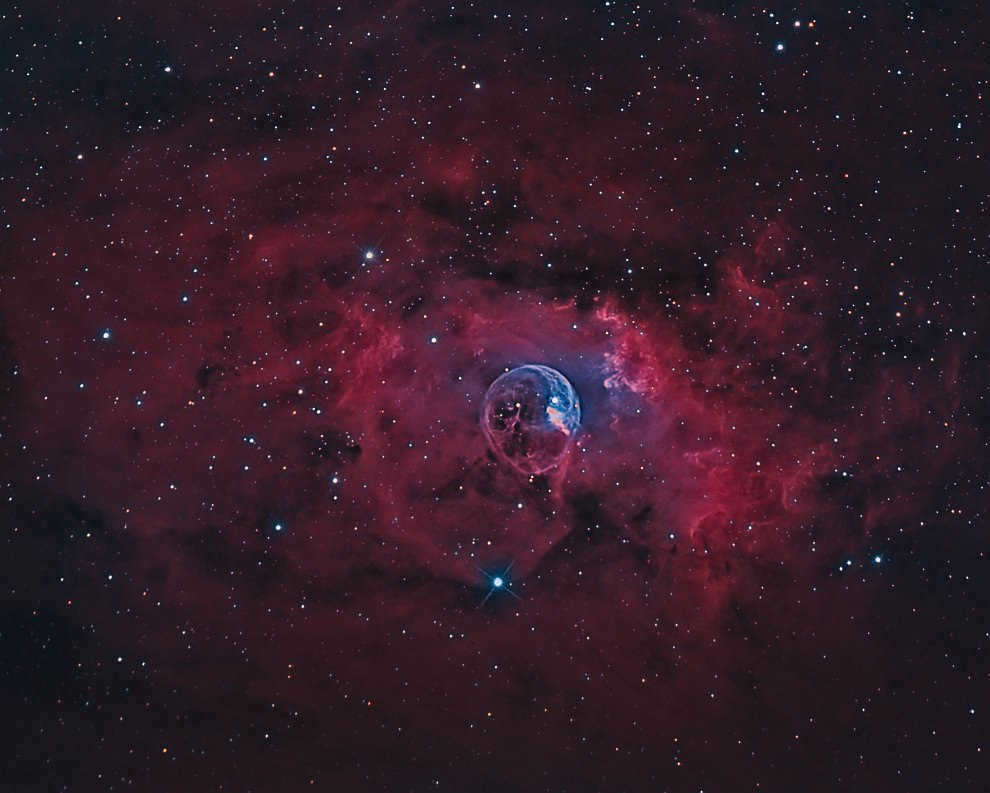
Picture of Bubble Emission Nebula
Now let’s go back to the previously observed star cluster M52. Towards the Southwest, at a distance of about 0.6O, we can observe a distinct group of four stars that form two adjacent triangles. The brightest star in this group has a magnitude of approximately 6.5m, while the other three stars have magnitudes ranging from 7 to 8.
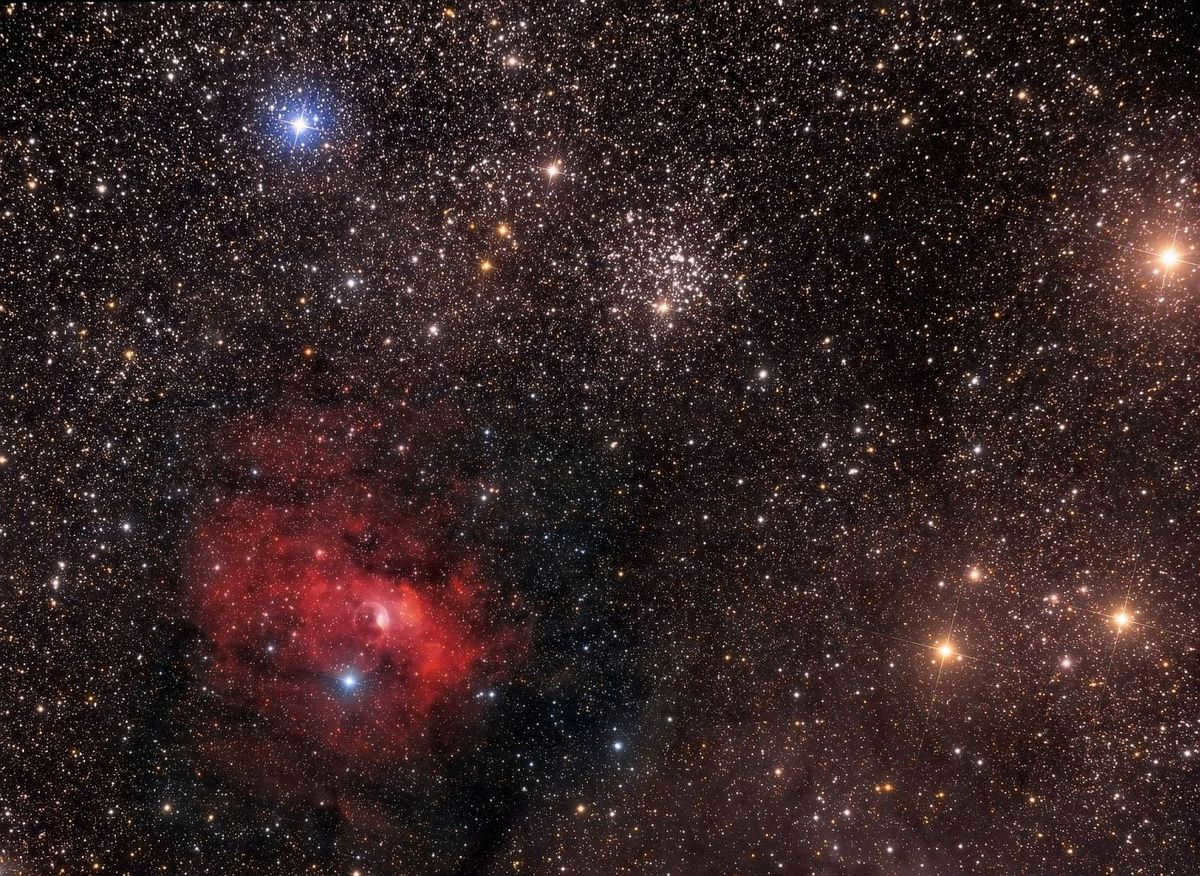

Here is a photograph showcasing the Bubble Nebula, which is also referred to as NGC 7635 and M52.
Located near the star that marks the less bright vertex of the adjacent side, you can find one of the most fascinating nebulae known as the Bubble Nebula or NGC 7635. Although it may not be the brightest object, its 11m brightness allows it to be easily identified even with a 70-80mm telescope. The nebula appears as an “outgrowth” separate from the nearby star and is surrounded by a subtle glow.
Experience a mesmerizing display of colors within the Bubble Nebula.
Visual representation showcasing the spatial arrangement of the nebula
Asterism Hrr12

Picture of the asterism known as Harrington 12
To pique our interest, let’s shift our gaze slightly higher (toward the North). Here we have a fascinating asterism, simply a random sequence of stars that are not physically connected. It is identified as Hrr12. Its intricate design is composed of stars with magnitudes ranging from 6 to 7 and resembles a miniature ladle with a straight handle of three stars pointing south.
Objects from the East in the constellation of Cassiopeia
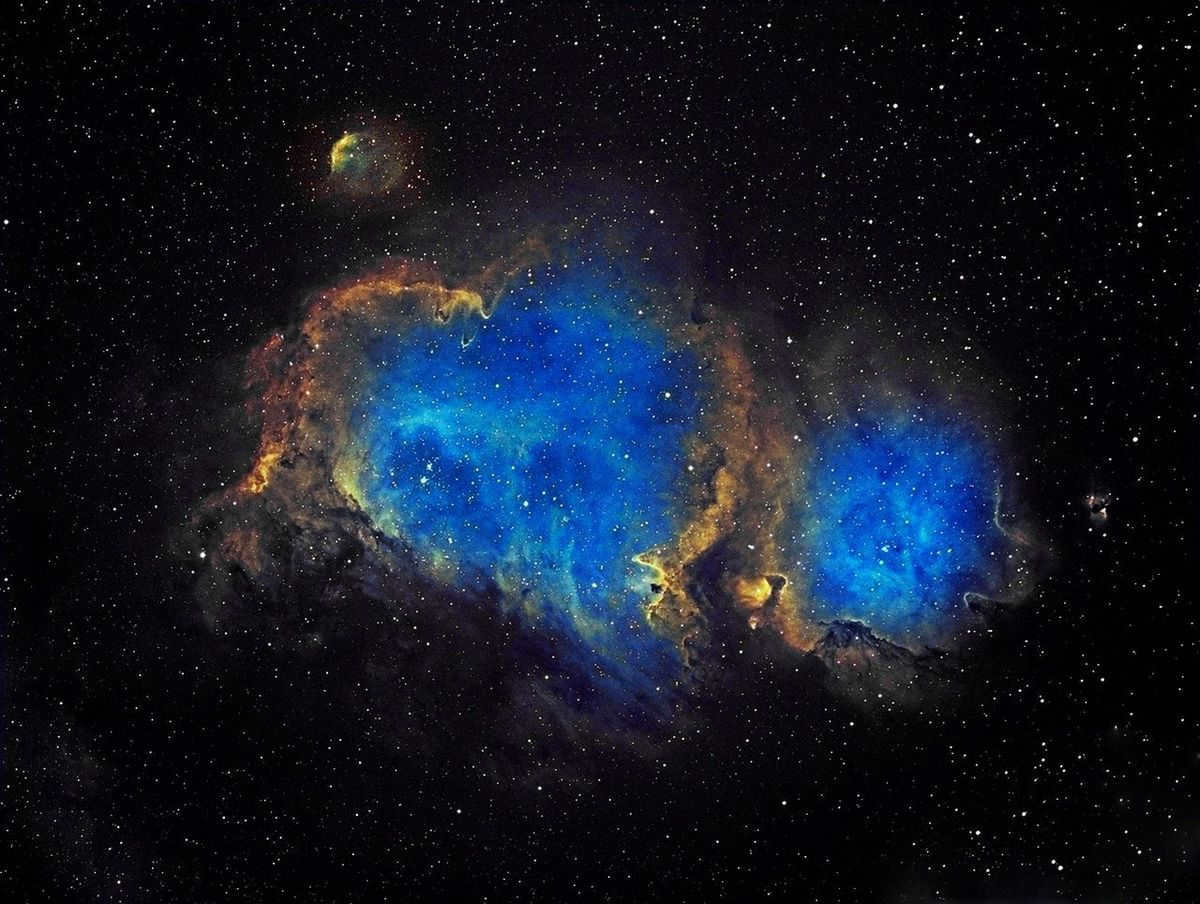
A stunning photograph showcasing the beauty of the Heart and Soul Nebula, also known as IC 1805, captured in visible light.
By utilizing a pair of binoculars, one can explore the celestial wonders that lie just south of the star δ Cas and slightly northeast along the δ-ε Cas line. Within this expansive field of view, a series of captivating clusters and nebulae can be observed, including Stock2, Mrk6, IC 1805, NGC 1027, IC 1848, Cr33, and Cr34.
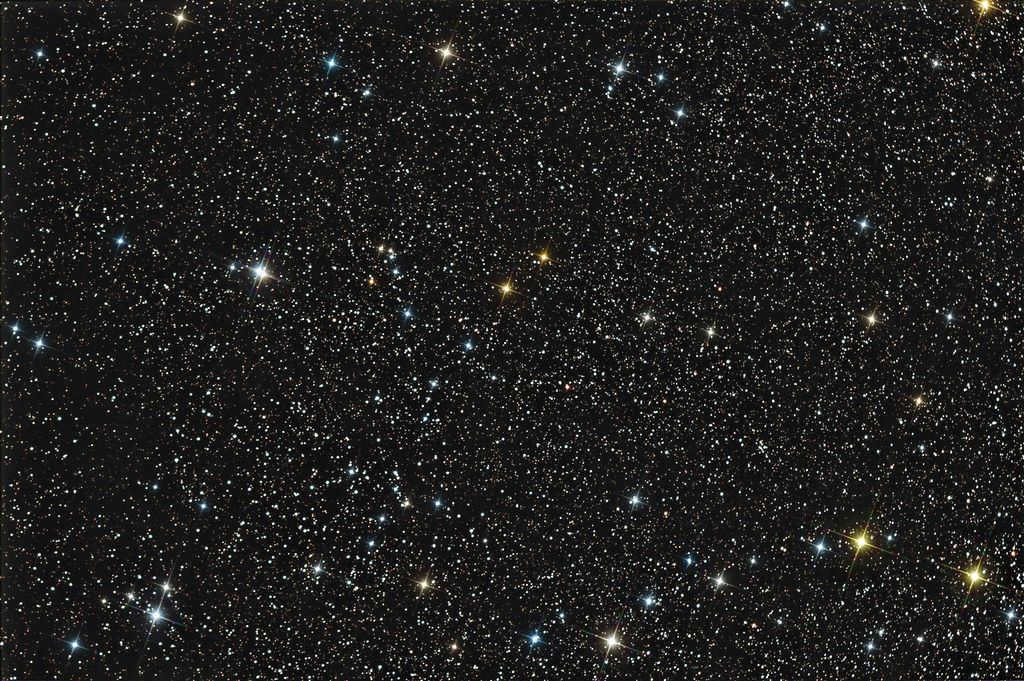
Stock2 Cluster of Dispersed Photos
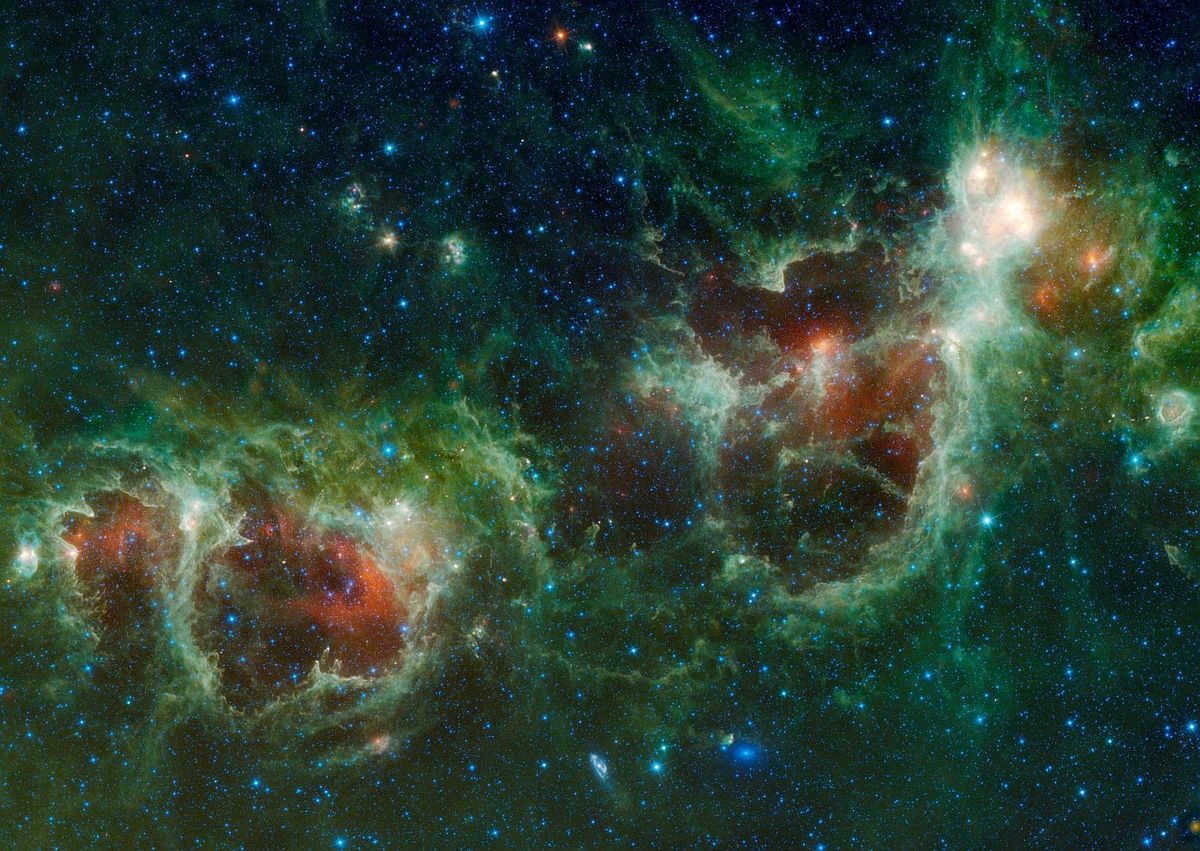
The Heart and Soul Nebula captured in the infrared spectrum provides a stunning visual experience.
Each individual element within this cosmic masterpiece demands individual recognition, and once discovered, they offer an awe-inspiring spectacle that is truly unforgettable.

Check out this amazing photo of the central part of the IC 1805 nebula!
The fascinating story behind the constellation

Drawing of Cassiopeia from an ancient atlas of the celestial sphere
The origins of the constellation can be traced back to Greek mythology. It was named after Queen Cassiopeia, who was the wife of Cepheus and the mother of Andromeda. According to one legend, the queen was punished for her sins and condemned to endlessly rotate, bound to her throne, around the celestial pole, flipping upside down every day. The modern depiction of the constellation was included in Claudius Ptolemy’s Almagest during the 2nd century.

